Classroom Social Climate and Student Learning
VerifiedAdded on 2023/01/17
|25
|6971
|1
AI Summary
This paper examines the importance and effects of classroom social climate on student learning. It explores the theoretical framework and approaches to creating a positive classroom environment. The role of teachers in shaping classroom social climate and the impact of teacher job satisfaction on student learning are also discussed.
Contribute Materials
Your contribution can guide someone’s learning journey. Share your
documents today.

Sociology
Name
Institution
Professor
Course
Date
Name
Institution
Professor
Course
Date
Secure Best Marks with AI Grader
Need help grading? Try our AI Grader for instant feedback on your assignments.
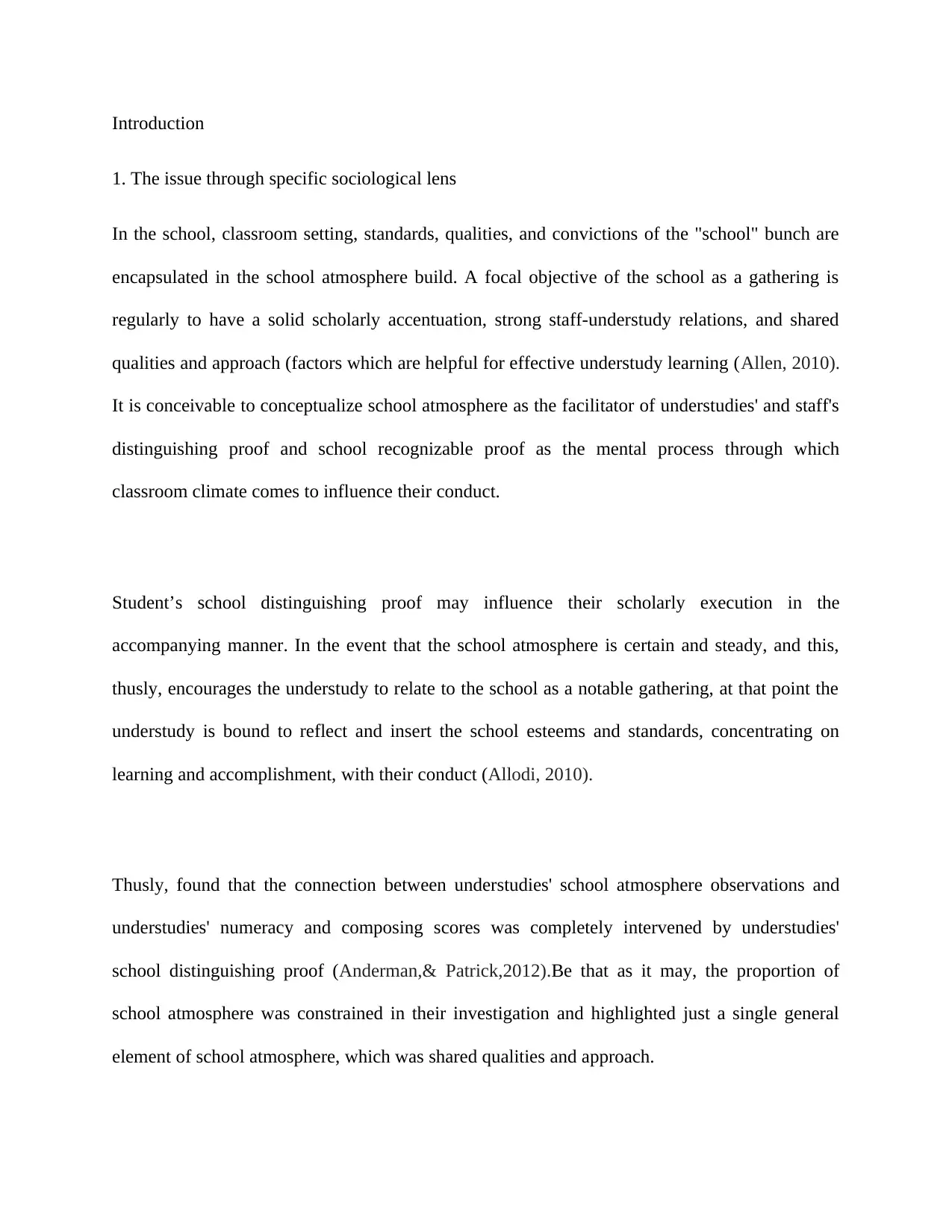
Introduction
1. The issue through specific sociological lens
In the school, classroom setting, standards, qualities, and convictions of the "school" bunch are
encapsulated in the school atmosphere build. A focal objective of the school as a gathering is
regularly to have a solid scholarly accentuation, strong staff-understudy relations, and shared
qualities and approach (factors which are helpful for effective understudy learning (Allen, 2010).
It is conceivable to conceptualize school atmosphere as the facilitator of understudies' and staff's
distinguishing proof and school recognizable proof as the mental process through which
classroom climate comes to influence their conduct.
Student’s school distinguishing proof may influence their scholarly execution in the
accompanying manner. In the event that the school atmosphere is certain and steady, and this,
thusly, encourages the understudy to relate to the school as a notable gathering, at that point the
understudy is bound to reflect and insert the school esteems and standards, concentrating on
learning and accomplishment, with their conduct (Allodi, 2010).
Thusly, found that the connection between understudies' school atmosphere observations and
understudies' numeracy and composing scores was completely intervened by understudies'
school distinguishing proof (Anderman,& Patrick,2012).Be that as it may, the proportion of
school atmosphere was constrained in their investigation and highlighted just a single general
element of school atmosphere, which was shared qualities and approach.
1. The issue through specific sociological lens
In the school, classroom setting, standards, qualities, and convictions of the "school" bunch are
encapsulated in the school atmosphere build. A focal objective of the school as a gathering is
regularly to have a solid scholarly accentuation, strong staff-understudy relations, and shared
qualities and approach (factors which are helpful for effective understudy learning (Allen, 2010).
It is conceivable to conceptualize school atmosphere as the facilitator of understudies' and staff's
distinguishing proof and school recognizable proof as the mental process through which
classroom climate comes to influence their conduct.
Student’s school distinguishing proof may influence their scholarly execution in the
accompanying manner. In the event that the school atmosphere is certain and steady, and this,
thusly, encourages the understudy to relate to the school as a notable gathering, at that point the
understudy is bound to reflect and insert the school esteems and standards, concentrating on
learning and accomplishment, with their conduct (Allodi, 2010).
Thusly, found that the connection between understudies' school atmosphere observations and
understudies' numeracy and composing scores was completely intervened by understudies'
school distinguishing proof (Anderman,& Patrick,2012).Be that as it may, the proportion of
school atmosphere was constrained in their investigation and highlighted just a single general
element of school atmosphere, which was shared qualities and approach.
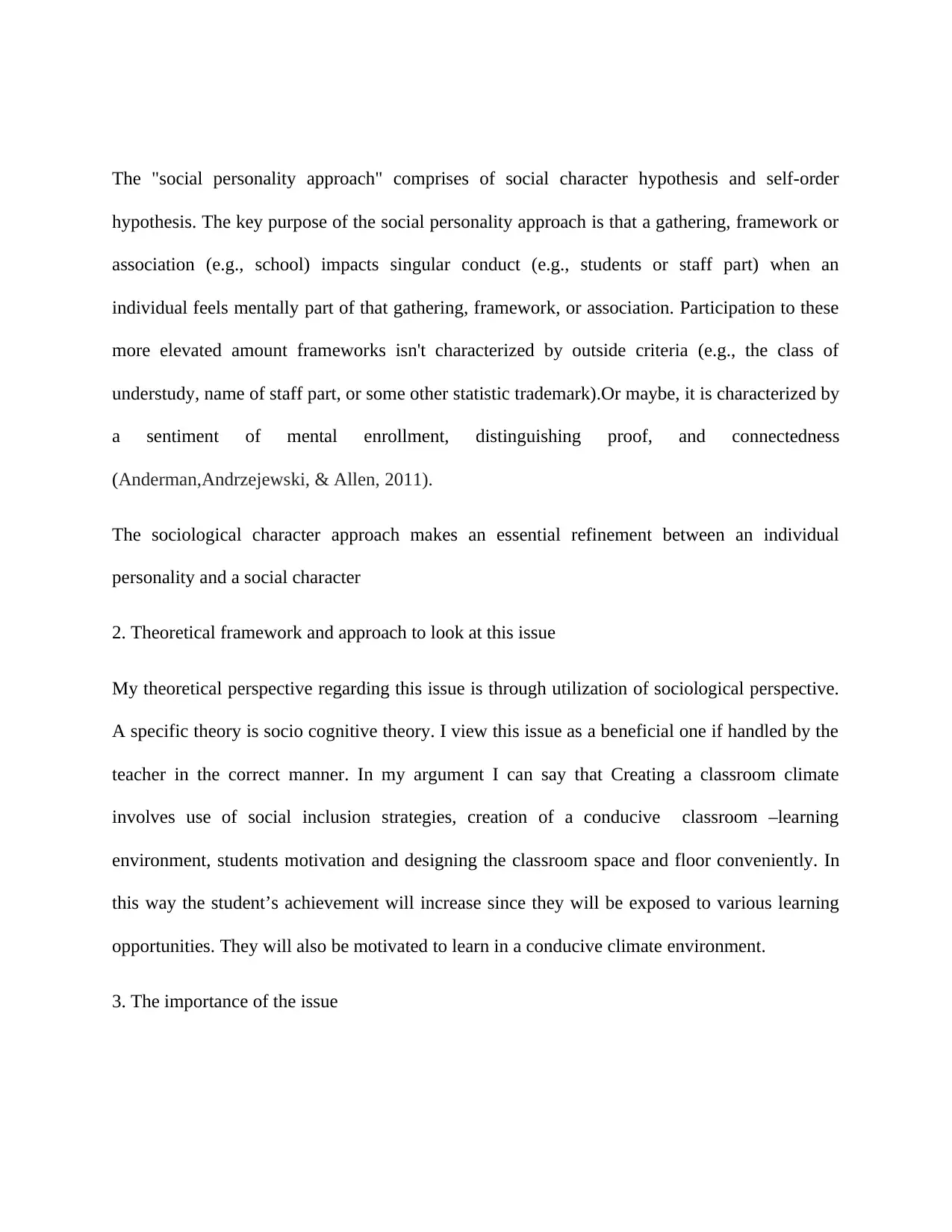
The "social personality approach" comprises of social character hypothesis and self-order
hypothesis. The key purpose of the social personality approach is that a gathering, framework or
association (e.g., school) impacts singular conduct (e.g., students or staff part) when an
individual feels mentally part of that gathering, framework, or association. Participation to these
more elevated amount frameworks isn't characterized by outside criteria (e.g., the class of
understudy, name of staff part, or some other statistic trademark).Or maybe, it is characterized by
a sentiment of mental enrollment, distinguishing proof, and connectedness
(Anderman,Andrzejewski, & Allen, 2011).
The sociological character approach makes an essential refinement between an individual
personality and a social character
2. Theoretical framework and approach to look at this issue
My theoretical perspective regarding this issue is through utilization of sociological perspective.
A specific theory is socio cognitive theory. I view this issue as a beneficial one if handled by the
teacher in the correct manner. In my argument I can say that Creating a classroom climate
involves use of social inclusion strategies, creation of a conducive classroom –learning
environment, students motivation and designing the classroom space and floor conveniently. In
this way the student’s achievement will increase since they will be exposed to various learning
opportunities. They will also be motivated to learn in a conducive climate environment.
3. The importance of the issue
hypothesis. The key purpose of the social personality approach is that a gathering, framework or
association (e.g., school) impacts singular conduct (e.g., students or staff part) when an
individual feels mentally part of that gathering, framework, or association. Participation to these
more elevated amount frameworks isn't characterized by outside criteria (e.g., the class of
understudy, name of staff part, or some other statistic trademark).Or maybe, it is characterized by
a sentiment of mental enrollment, distinguishing proof, and connectedness
(Anderman,Andrzejewski, & Allen, 2011).
The sociological character approach makes an essential refinement between an individual
personality and a social character
2. Theoretical framework and approach to look at this issue
My theoretical perspective regarding this issue is through utilization of sociological perspective.
A specific theory is socio cognitive theory. I view this issue as a beneficial one if handled by the
teacher in the correct manner. In my argument I can say that Creating a classroom climate
involves use of social inclusion strategies, creation of a conducive classroom –learning
environment, students motivation and designing the classroom space and floor conveniently. In
this way the student’s achievement will increase since they will be exposed to various learning
opportunities. They will also be motivated to learn in a conducive climate environment.
3. The importance of the issue
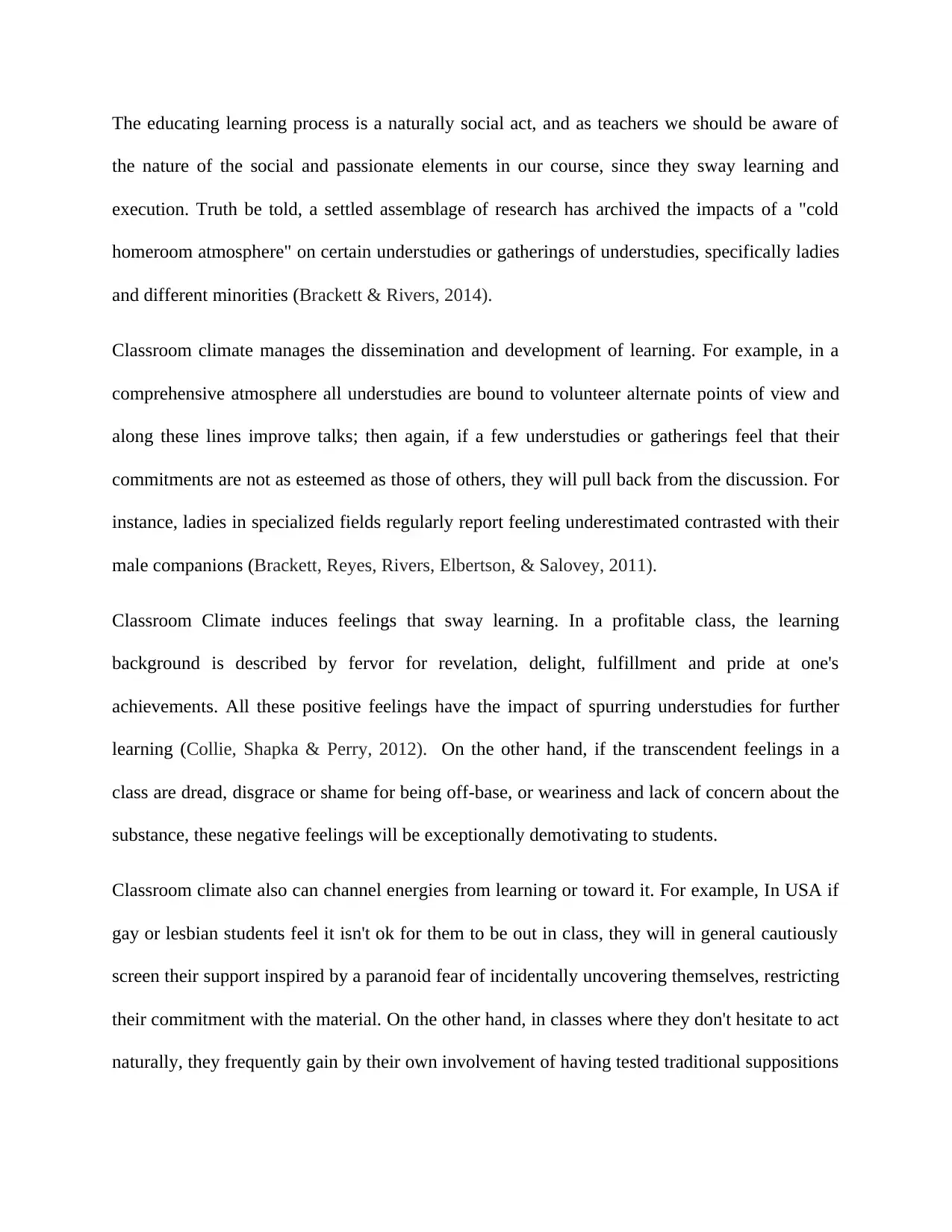
The educating learning process is a naturally social act, and as teachers we should be aware of
the nature of the social and passionate elements in our course, since they sway learning and
execution. Truth be told, a settled assemblage of research has archived the impacts of a "cold
homeroom atmosphere" on certain understudies or gatherings of understudies, specifically ladies
and different minorities (Brackett & Rivers, 2014).
Classroom climate manages the dissemination and development of learning. For example, in a
comprehensive atmosphere all understudies are bound to volunteer alternate points of view and
along these lines improve talks; then again, if a few understudies or gatherings feel that their
commitments are not as esteemed as those of others, they will pull back from the discussion. For
instance, ladies in specialized fields regularly report feeling underestimated contrasted with their
male companions (Brackett, Reyes, Rivers, Elbertson, & Salovey, 2011).
Classroom Climate induces feelings that sway learning. In a profitable class, the learning
background is described by fervor for revelation, delight, fulfillment and pride at one's
achievements. All these positive feelings have the impact of spurring understudies for further
learning (Collie, Shapka & Perry, 2012). On the other hand, if the transcendent feelings in a
class are dread, disgrace or shame for being off-base, or weariness and lack of concern about the
substance, these negative feelings will be exceptionally demotivating to students.
Classroom climate also can channel energies from learning or toward it. For example, In USA if
gay or lesbian students feel it isn't ok for them to be out in class, they will in general cautiously
screen their support inspired by a paranoid fear of incidentally uncovering themselves, restricting
their commitment with the material. On the other hand, in classes where they don't hesitate to act
naturally, they frequently gain by their own involvement of having tested traditional suppositions
the nature of the social and passionate elements in our course, since they sway learning and
execution. Truth be told, a settled assemblage of research has archived the impacts of a "cold
homeroom atmosphere" on certain understudies or gatherings of understudies, specifically ladies
and different minorities (Brackett & Rivers, 2014).
Classroom climate manages the dissemination and development of learning. For example, in a
comprehensive atmosphere all understudies are bound to volunteer alternate points of view and
along these lines improve talks; then again, if a few understudies or gatherings feel that their
commitments are not as esteemed as those of others, they will pull back from the discussion. For
instance, ladies in specialized fields regularly report feeling underestimated contrasted with their
male companions (Brackett, Reyes, Rivers, Elbertson, & Salovey, 2011).
Classroom Climate induces feelings that sway learning. In a profitable class, the learning
background is described by fervor for revelation, delight, fulfillment and pride at one's
achievements. All these positive feelings have the impact of spurring understudies for further
learning (Collie, Shapka & Perry, 2012). On the other hand, if the transcendent feelings in a
class are dread, disgrace or shame for being off-base, or weariness and lack of concern about the
substance, these negative feelings will be exceptionally demotivating to students.
Classroom climate also can channel energies from learning or toward it. For example, In USA if
gay or lesbian students feel it isn't ok for them to be out in class, they will in general cautiously
screen their support inspired by a paranoid fear of incidentally uncovering themselves, restricting
their commitment with the material. On the other hand, in classes where they don't hesitate to act
naturally, they frequently gain by their own involvement of having tested traditional suppositions
Secure Best Marks with AI Grader
Need help grading? Try our AI Grader for instant feedback on your assignments.
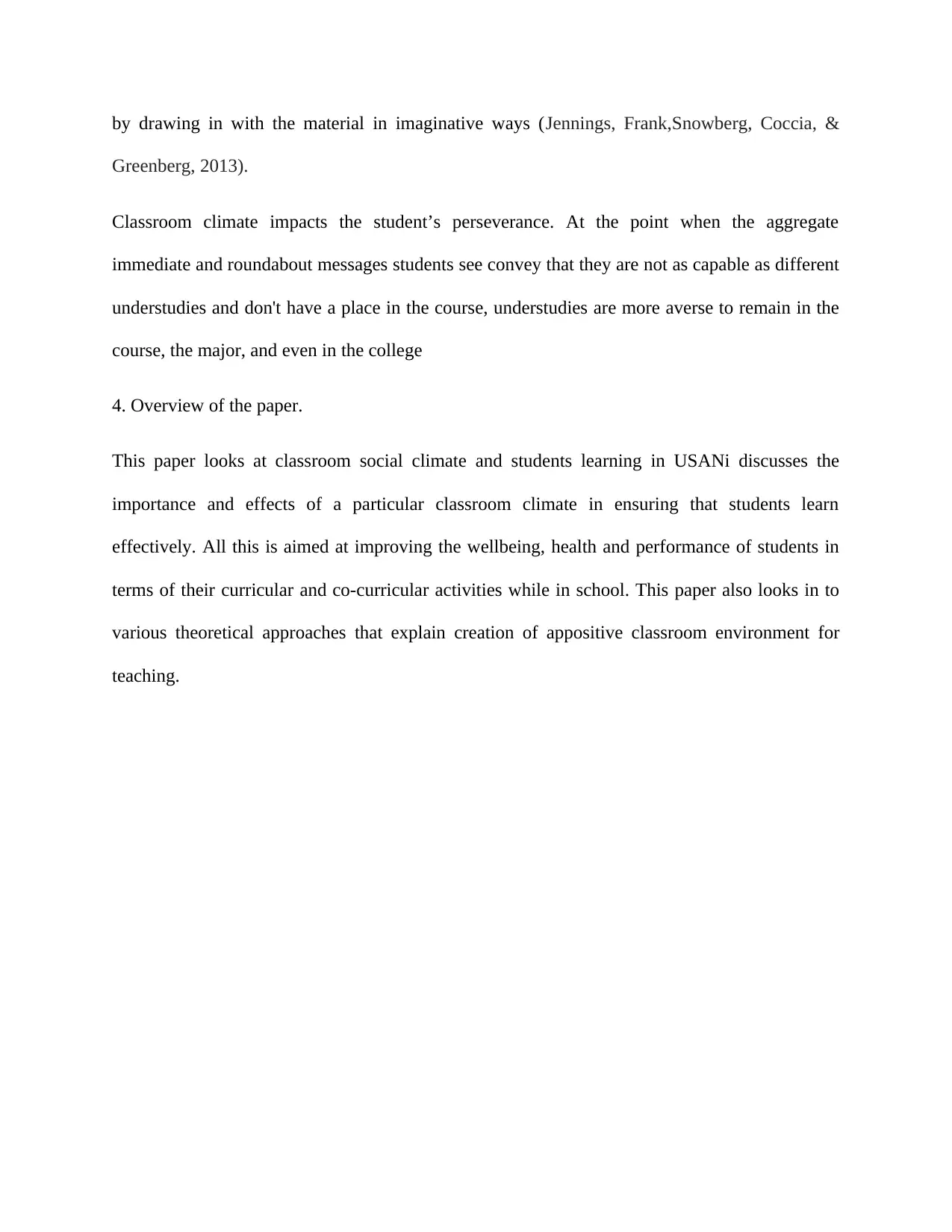
by drawing in with the material in imaginative ways (Jennings, Frank,Snowberg, Coccia, &
Greenberg, 2013).
Classroom climate impacts the student’s perseverance. At the point when the aggregate
immediate and roundabout messages students see convey that they are not as capable as different
understudies and don't have a place in the course, understudies are more averse to remain in the
course, the major, and even in the college
4. Overview of the paper.
This paper looks at classroom social climate and students learning in USANi discusses the
importance and effects of a particular classroom climate in ensuring that students learn
effectively. All this is aimed at improving the wellbeing, health and performance of students in
terms of their curricular and co-curricular activities while in school. This paper also looks in to
various theoretical approaches that explain creation of appositive classroom environment for
teaching.
Greenberg, 2013).
Classroom climate impacts the student’s perseverance. At the point when the aggregate
immediate and roundabout messages students see convey that they are not as capable as different
understudies and don't have a place in the course, understudies are more averse to remain in the
course, the major, and even in the college
4. Overview of the paper.
This paper looks at classroom social climate and students learning in USANi discusses the
importance and effects of a particular classroom climate in ensuring that students learn
effectively. All this is aimed at improving the wellbeing, health and performance of students in
terms of their curricular and co-curricular activities while in school. This paper also looks in to
various theoretical approaches that explain creation of appositive classroom environment for
teaching.
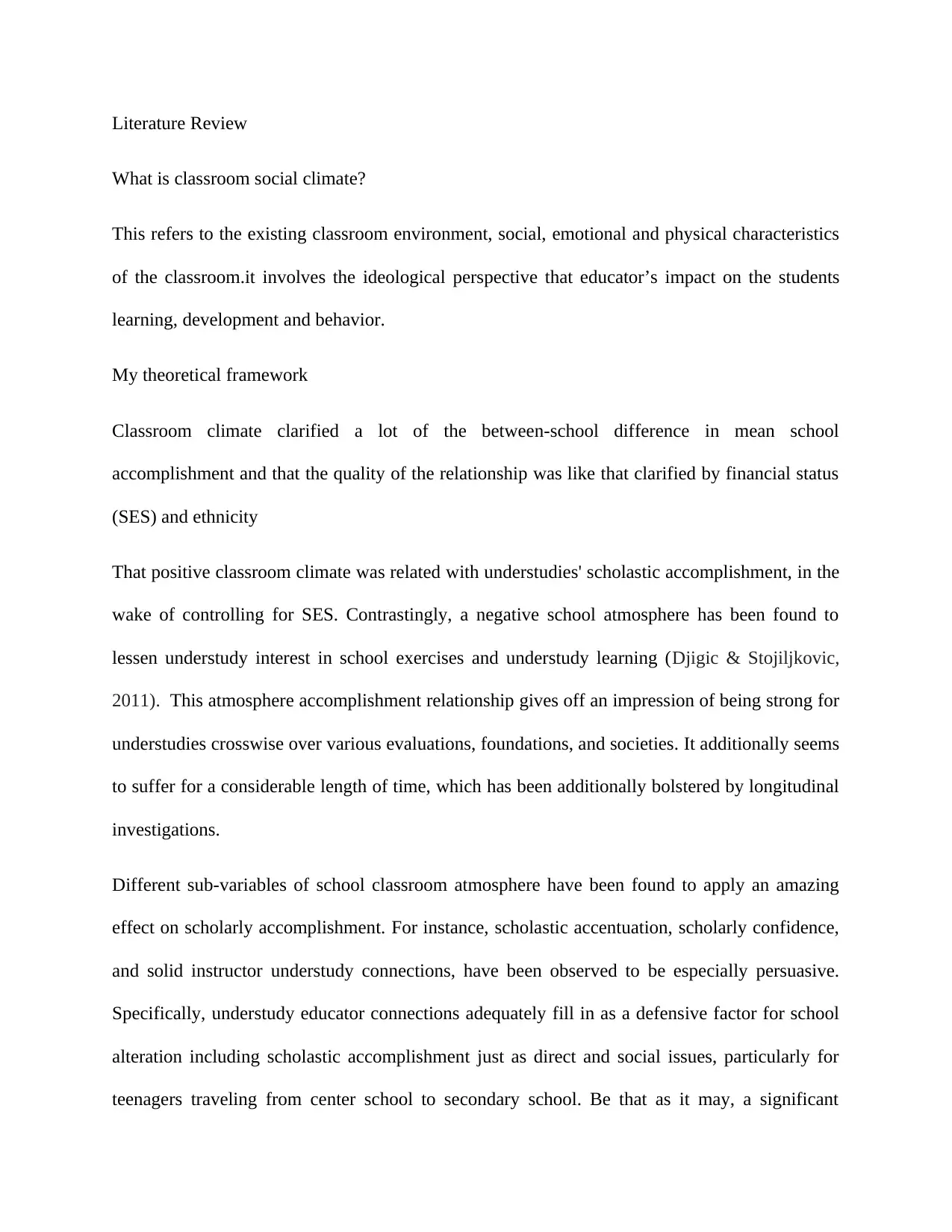
Literature Review
What is classroom social climate?
This refers to the existing classroom environment, social, emotional and physical characteristics
of the classroom.it involves the ideological perspective that educator’s impact on the students
learning, development and behavior.
My theoretical framework
Classroom climate clarified a lot of the between-school difference in mean school
accomplishment and that the quality of the relationship was like that clarified by financial status
(SES) and ethnicity
That positive classroom climate was related with understudies' scholastic accomplishment, in the
wake of controlling for SES. Contrastingly, a negative school atmosphere has been found to
lessen understudy interest in school exercises and understudy learning (Djigic & Stojiljkovic,
2011). This atmosphere accomplishment relationship gives off an impression of being strong for
understudies crosswise over various evaluations, foundations, and societies. It additionally seems
to suffer for a considerable length of time, which has been additionally bolstered by longitudinal
investigations.
Different sub-variables of school classroom atmosphere have been found to apply an amazing
effect on scholarly accomplishment. For instance, scholastic accentuation, scholarly confidence,
and solid instructor understudy connections, have been observed to be especially persuasive.
Specifically, understudy educator connections adequately fill in as a defensive factor for school
alteration including scholastic accomplishment just as direct and social issues, particularly for
teenagers traveling from center school to secondary school. Be that as it may, a significant
What is classroom social climate?
This refers to the existing classroom environment, social, emotional and physical characteristics
of the classroom.it involves the ideological perspective that educator’s impact on the students
learning, development and behavior.
My theoretical framework
Classroom climate clarified a lot of the between-school difference in mean school
accomplishment and that the quality of the relationship was like that clarified by financial status
(SES) and ethnicity
That positive classroom climate was related with understudies' scholastic accomplishment, in the
wake of controlling for SES. Contrastingly, a negative school atmosphere has been found to
lessen understudy interest in school exercises and understudy learning (Djigic & Stojiljkovic,
2011). This atmosphere accomplishment relationship gives off an impression of being strong for
understudies crosswise over various evaluations, foundations, and societies. It additionally seems
to suffer for a considerable length of time, which has been additionally bolstered by longitudinal
investigations.
Different sub-variables of school classroom atmosphere have been found to apply an amazing
effect on scholarly accomplishment. For instance, scholastic accentuation, scholarly confidence,
and solid instructor understudy connections, have been observed to be especially persuasive.
Specifically, understudy educator connections adequately fill in as a defensive factor for school
alteration including scholastic accomplishment just as direct and social issues, particularly for
teenagers traveling from center school to secondary school. Be that as it may, a significant
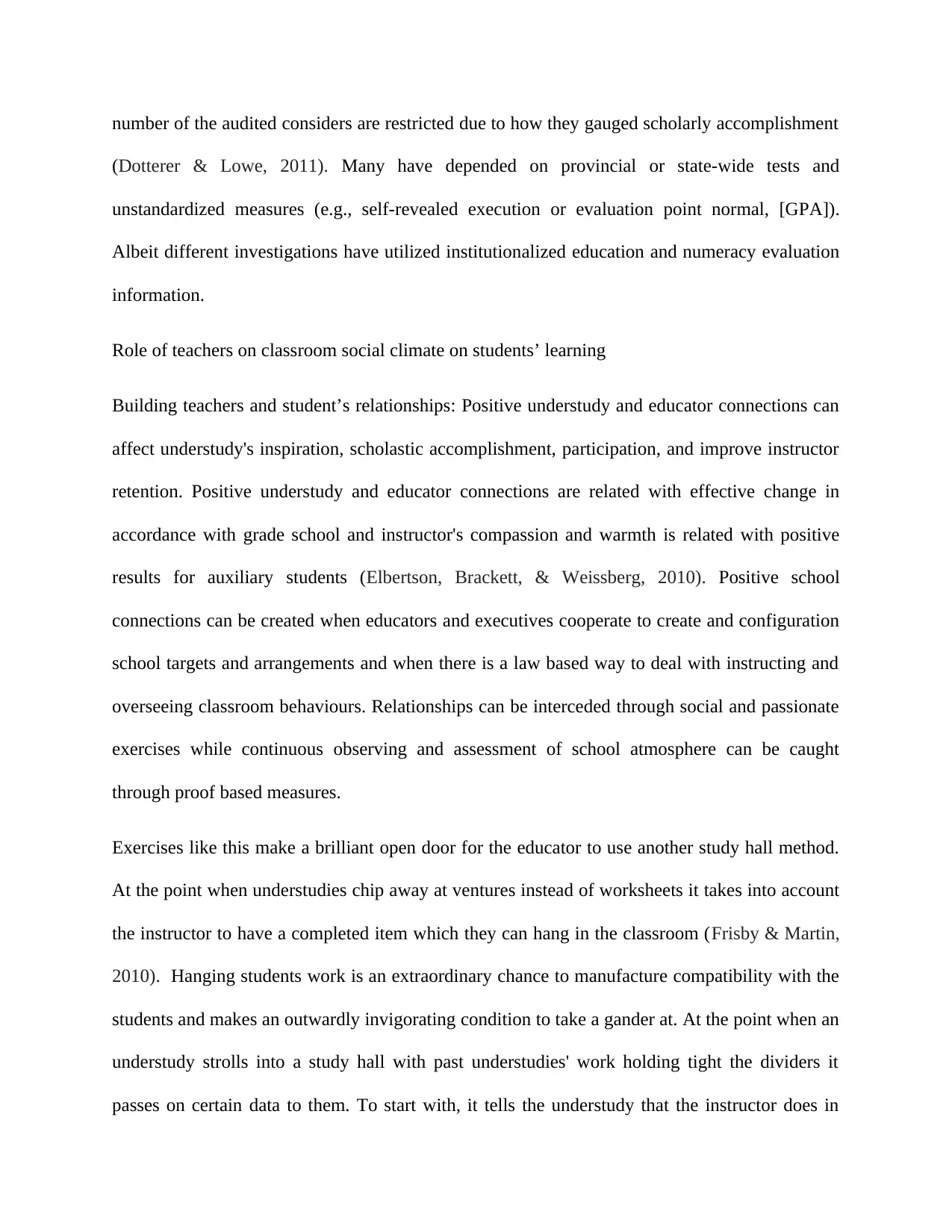
number of the audited considers are restricted due to how they gauged scholarly accomplishment
(Dotterer & Lowe, 2011). Many have depended on provincial or state-wide tests and
unstandardized measures (e.g., self-revealed execution or evaluation point normal, [GPA]).
Albeit different investigations have utilized institutionalized education and numeracy evaluation
information.
Role of teachers on classroom social climate on students’ learning
Building teachers and student’s relationships: Positive understudy and educator connections can
affect understudy's inspiration, scholastic accomplishment, participation, and improve instructor
retention. Positive understudy and educator connections are related with effective change in
accordance with grade school and instructor's compassion and warmth is related with positive
results for auxiliary students (Elbertson, Brackett, & Weissberg, 2010). Positive school
connections can be created when educators and executives cooperate to create and configuration
school targets and arrangements and when there is a law based way to deal with instructing and
overseeing classroom behaviours. Relationships can be interceded through social and passionate
exercises while continuous observing and assessment of school atmosphere can be caught
through proof based measures.
Exercises like this make a brilliant open door for the educator to use another study hall method.
At the point when understudies chip away at ventures instead of worksheets it takes into account
the instructor to have a completed item which they can hang in the classroom (Frisby & Martin,
2010). Hanging students work is an extraordinary chance to manufacture compatibility with the
students and makes an outwardly invigorating condition to take a gander at. At the point when an
understudy strolls into a study hall with past understudies' work holding tight the dividers it
passes on certain data to them. To start with, it tells the understudy that the instructor does in
(Dotterer & Lowe, 2011). Many have depended on provincial or state-wide tests and
unstandardized measures (e.g., self-revealed execution or evaluation point normal, [GPA]).
Albeit different investigations have utilized institutionalized education and numeracy evaluation
information.
Role of teachers on classroom social climate on students’ learning
Building teachers and student’s relationships: Positive understudy and educator connections can
affect understudy's inspiration, scholastic accomplishment, participation, and improve instructor
retention. Positive understudy and educator connections are related with effective change in
accordance with grade school and instructor's compassion and warmth is related with positive
results for auxiliary students (Elbertson, Brackett, & Weissberg, 2010). Positive school
connections can be created when educators and executives cooperate to create and configuration
school targets and arrangements and when there is a law based way to deal with instructing and
overseeing classroom behaviours. Relationships can be interceded through social and passionate
exercises while continuous observing and assessment of school atmosphere can be caught
through proof based measures.
Exercises like this make a brilliant open door for the educator to use another study hall method.
At the point when understudies chip away at ventures instead of worksheets it takes into account
the instructor to have a completed item which they can hang in the classroom (Frisby & Martin,
2010). Hanging students work is an extraordinary chance to manufacture compatibility with the
students and makes an outwardly invigorating condition to take a gander at. At the point when an
understudy strolls into a study hall with past understudies' work holding tight the dividers it
passes on certain data to them. To start with, it tells the understudy that the instructor does in
Paraphrase This Document
Need a fresh take? Get an instant paraphrase of this document with our AI Paraphraser
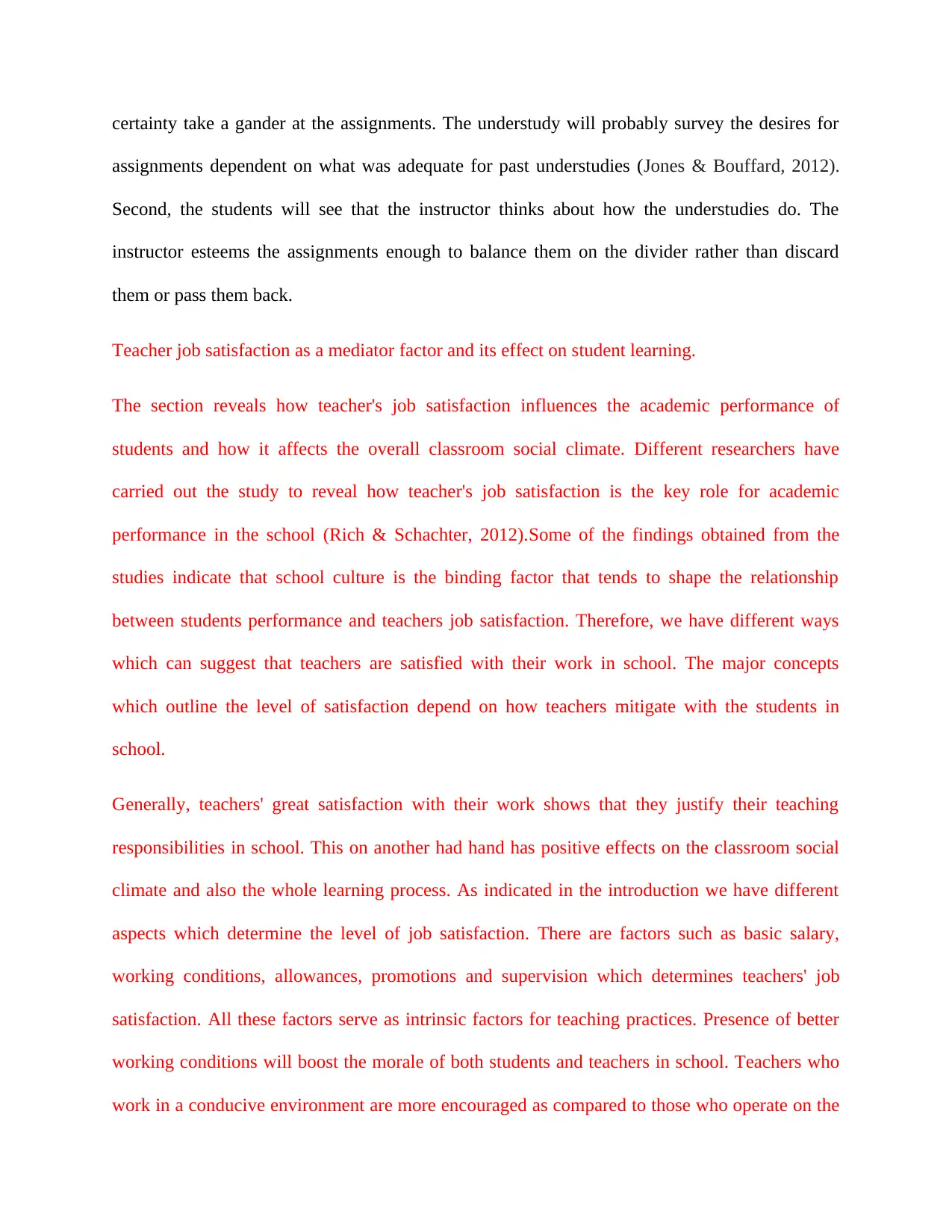
certainty take a gander at the assignments. The understudy will probably survey the desires for
assignments dependent on what was adequate for past understudies (Jones & Bouffard, 2012).
Second, the students will see that the instructor thinks about how the understudies do. The
instructor esteems the assignments enough to balance them on the divider rather than discard
them or pass them back.
Teacher job satisfaction as a mediator factor and its effect on student learning.
The section reveals how teacher's job satisfaction influences the academic performance of
students and how it affects the overall classroom social climate. Different researchers have
carried out the study to reveal how teacher's job satisfaction is the key role for academic
performance in the school (Rich & Schachter, 2012).Some of the findings obtained from the
studies indicate that school culture is the binding factor that tends to shape the relationship
between students performance and teachers job satisfaction. Therefore, we have different ways
which can suggest that teachers are satisfied with their work in school. The major concepts
which outline the level of satisfaction depend on how teachers mitigate with the students in
school.
Generally, teachers' great satisfaction with their work shows that they justify their teaching
responsibilities in school. This on another had hand has positive effects on the classroom social
climate and also the whole learning process. As indicated in the introduction we have different
aspects which determine the level of job satisfaction. There are factors such as basic salary,
working conditions, allowances, promotions and supervision which determines teachers' job
satisfaction. All these factors serve as intrinsic factors for teaching practices. Presence of better
working conditions will boost the morale of both students and teachers in school. Teachers who
work in a conducive environment are more encouraged as compared to those who operate on the
assignments dependent on what was adequate for past understudies (Jones & Bouffard, 2012).
Second, the students will see that the instructor thinks about how the understudies do. The
instructor esteems the assignments enough to balance them on the divider rather than discard
them or pass them back.
Teacher job satisfaction as a mediator factor and its effect on student learning.
The section reveals how teacher's job satisfaction influences the academic performance of
students and how it affects the overall classroom social climate. Different researchers have
carried out the study to reveal how teacher's job satisfaction is the key role for academic
performance in the school (Rich & Schachter, 2012).Some of the findings obtained from the
studies indicate that school culture is the binding factor that tends to shape the relationship
between students performance and teachers job satisfaction. Therefore, we have different ways
which can suggest that teachers are satisfied with their work in school. The major concepts
which outline the level of satisfaction depend on how teachers mitigate with the students in
school.
Generally, teachers' great satisfaction with their work shows that they justify their teaching
responsibilities in school. This on another had hand has positive effects on the classroom social
climate and also the whole learning process. As indicated in the introduction we have different
aspects which determine the level of job satisfaction. There are factors such as basic salary,
working conditions, allowances, promotions and supervision which determines teachers' job
satisfaction. All these factors serve as intrinsic factors for teaching practices. Presence of better
working conditions will boost the morale of both students and teachers in school. Teachers who
work in a conducive environment are more encouraged as compared to those who operate on the
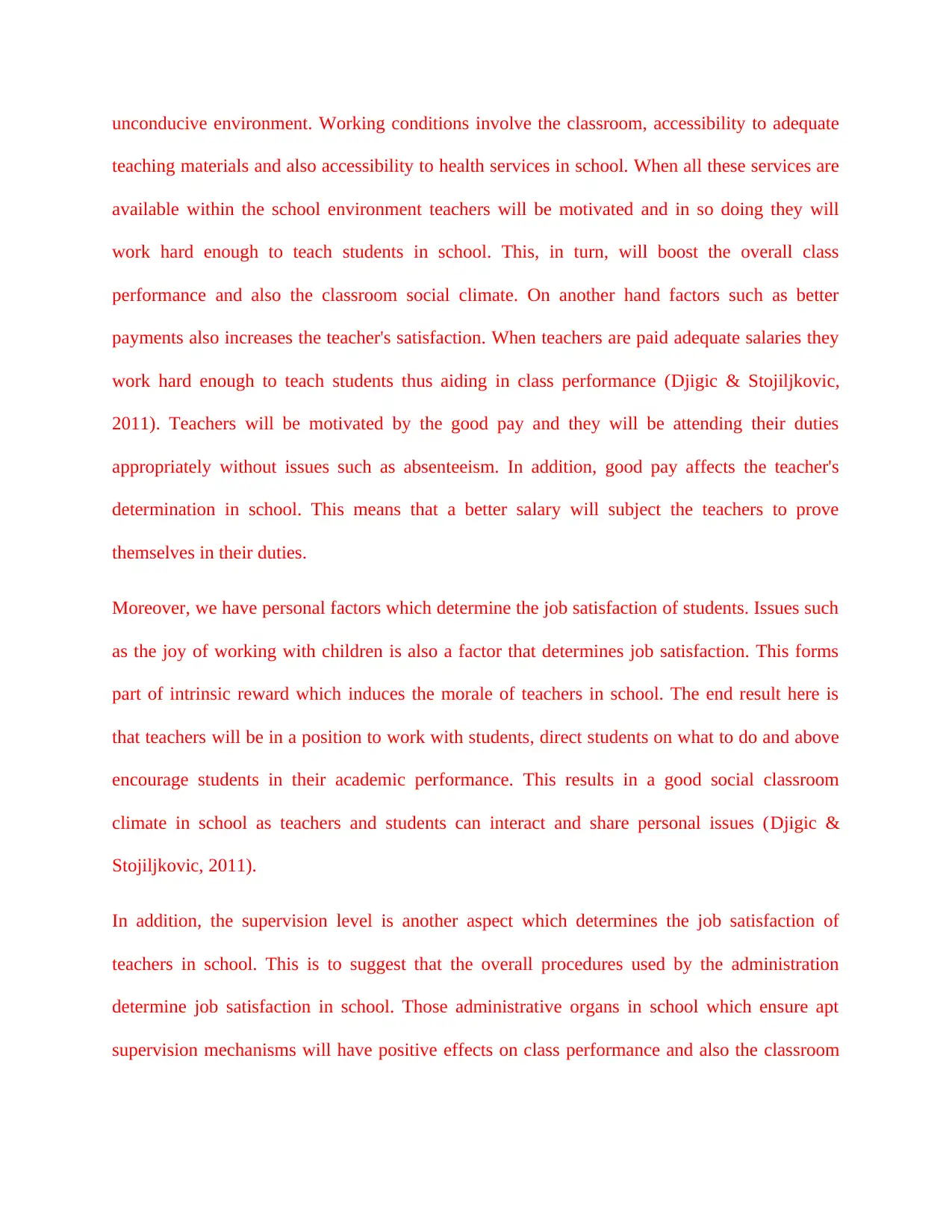
unconducive environment. Working conditions involve the classroom, accessibility to adequate
teaching materials and also accessibility to health services in school. When all these services are
available within the school environment teachers will be motivated and in so doing they will
work hard enough to teach students in school. This, in turn, will boost the overall class
performance and also the classroom social climate. On another hand factors such as better
payments also increases the teacher's satisfaction. When teachers are paid adequate salaries they
work hard enough to teach students thus aiding in class performance (Djigic & Stojiljkovic,
2011). Teachers will be motivated by the good pay and they will be attending their duties
appropriately without issues such as absenteeism. In addition, good pay affects the teacher's
determination in school. This means that a better salary will subject the teachers to prove
themselves in their duties.
Moreover, we have personal factors which determine the job satisfaction of students. Issues such
as the joy of working with children is also a factor that determines job satisfaction. This forms
part of intrinsic reward which induces the morale of teachers in school. The end result here is
that teachers will be in a position to work with students, direct students on what to do and above
encourage students in their academic performance. This results in a good social classroom
climate in school as teachers and students can interact and share personal issues (Djigic &
Stojiljkovic, 2011).
In addition, the supervision level is another aspect which determines the job satisfaction of
teachers in school. This is to suggest that the overall procedures used by the administration
determine job satisfaction in school. Those administrative organs in school which ensure apt
supervision mechanisms will have positive effects on class performance and also the classroom
teaching materials and also accessibility to health services in school. When all these services are
available within the school environment teachers will be motivated and in so doing they will
work hard enough to teach students in school. This, in turn, will boost the overall class
performance and also the classroom social climate. On another hand factors such as better
payments also increases the teacher's satisfaction. When teachers are paid adequate salaries they
work hard enough to teach students thus aiding in class performance (Djigic & Stojiljkovic,
2011). Teachers will be motivated by the good pay and they will be attending their duties
appropriately without issues such as absenteeism. In addition, good pay affects the teacher's
determination in school. This means that a better salary will subject the teachers to prove
themselves in their duties.
Moreover, we have personal factors which determine the job satisfaction of students. Issues such
as the joy of working with children is also a factor that determines job satisfaction. This forms
part of intrinsic reward which induces the morale of teachers in school. The end result here is
that teachers will be in a position to work with students, direct students on what to do and above
encourage students in their academic performance. This results in a good social classroom
climate in school as teachers and students can interact and share personal issues (Djigic &
Stojiljkovic, 2011).
In addition, the supervision level is another aspect which determines the job satisfaction of
teachers in school. This is to suggest that the overall procedures used by the administration
determine job satisfaction in school. Those administrative organs in school which ensure apt
supervision mechanisms will have positive effects on class performance and also the classroom
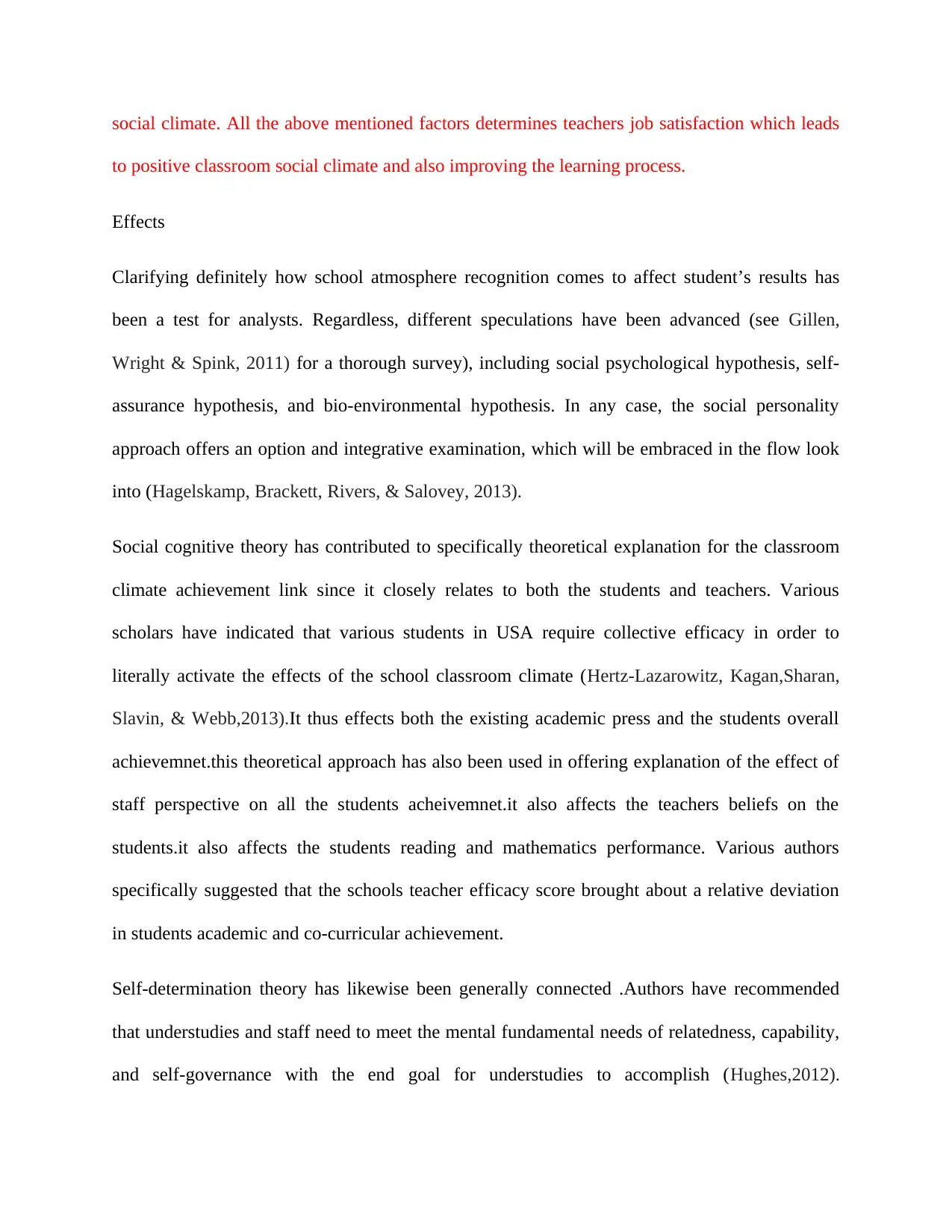
social climate. All the above mentioned factors determines teachers job satisfaction which leads
to positive classroom social climate and also improving the learning process.
Effects
Clarifying definitely how school atmosphere recognition comes to affect student’s results has
been a test for analysts. Regardless, different speculations have been advanced (see Gillen,
Wright & Spink, 2011) for a thorough survey), including social psychological hypothesis, self-
assurance hypothesis, and bio-environmental hypothesis. In any case, the social personality
approach offers an option and integrative examination, which will be embraced in the flow look
into (Hagelskamp, Brackett, Rivers, & Salovey, 2013).
Social cognitive theory has contributed to specifically theoretical explanation for the classroom
climate achievement link since it closely relates to both the students and teachers. Various
scholars have indicated that various students in USA require collective efficacy in order to
literally activate the effects of the school classroom climate (Hertz-Lazarowitz, Kagan,Sharan,
Slavin, & Webb,2013).It thus effects both the existing academic press and the students overall
achievemnet.this theoretical approach has also been used in offering explanation of the effect of
staff perspective on all the students acheivemnet.it also affects the teachers beliefs on the
students.it also affects the students reading and mathematics performance. Various authors
specifically suggested that the schools teacher efficacy score brought about a relative deviation
in students academic and co-curricular achievement.
Self-determination theory has likewise been generally connected .Authors have recommended
that understudies and staff need to meet the mental fundamental needs of relatedness, capability,
and self-governance with the end goal for understudies to accomplish (Hughes,2012).
to positive classroom social climate and also improving the learning process.
Effects
Clarifying definitely how school atmosphere recognition comes to affect student’s results has
been a test for analysts. Regardless, different speculations have been advanced (see Gillen,
Wright & Spink, 2011) for a thorough survey), including social psychological hypothesis, self-
assurance hypothesis, and bio-environmental hypothesis. In any case, the social personality
approach offers an option and integrative examination, which will be embraced in the flow look
into (Hagelskamp, Brackett, Rivers, & Salovey, 2013).
Social cognitive theory has contributed to specifically theoretical explanation for the classroom
climate achievement link since it closely relates to both the students and teachers. Various
scholars have indicated that various students in USA require collective efficacy in order to
literally activate the effects of the school classroom climate (Hertz-Lazarowitz, Kagan,Sharan,
Slavin, & Webb,2013).It thus effects both the existing academic press and the students overall
achievemnet.this theoretical approach has also been used in offering explanation of the effect of
staff perspective on all the students acheivemnet.it also affects the teachers beliefs on the
students.it also affects the students reading and mathematics performance. Various authors
specifically suggested that the schools teacher efficacy score brought about a relative deviation
in students academic and co-curricular achievement.
Self-determination theory has likewise been generally connected .Authors have recommended
that understudies and staff need to meet the mental fundamental needs of relatedness, capability,
and self-governance with the end goal for understudies to accomplish (Hughes,2012).
Secure Best Marks with AI Grader
Need help grading? Try our AI Grader for instant feedback on your assignments.
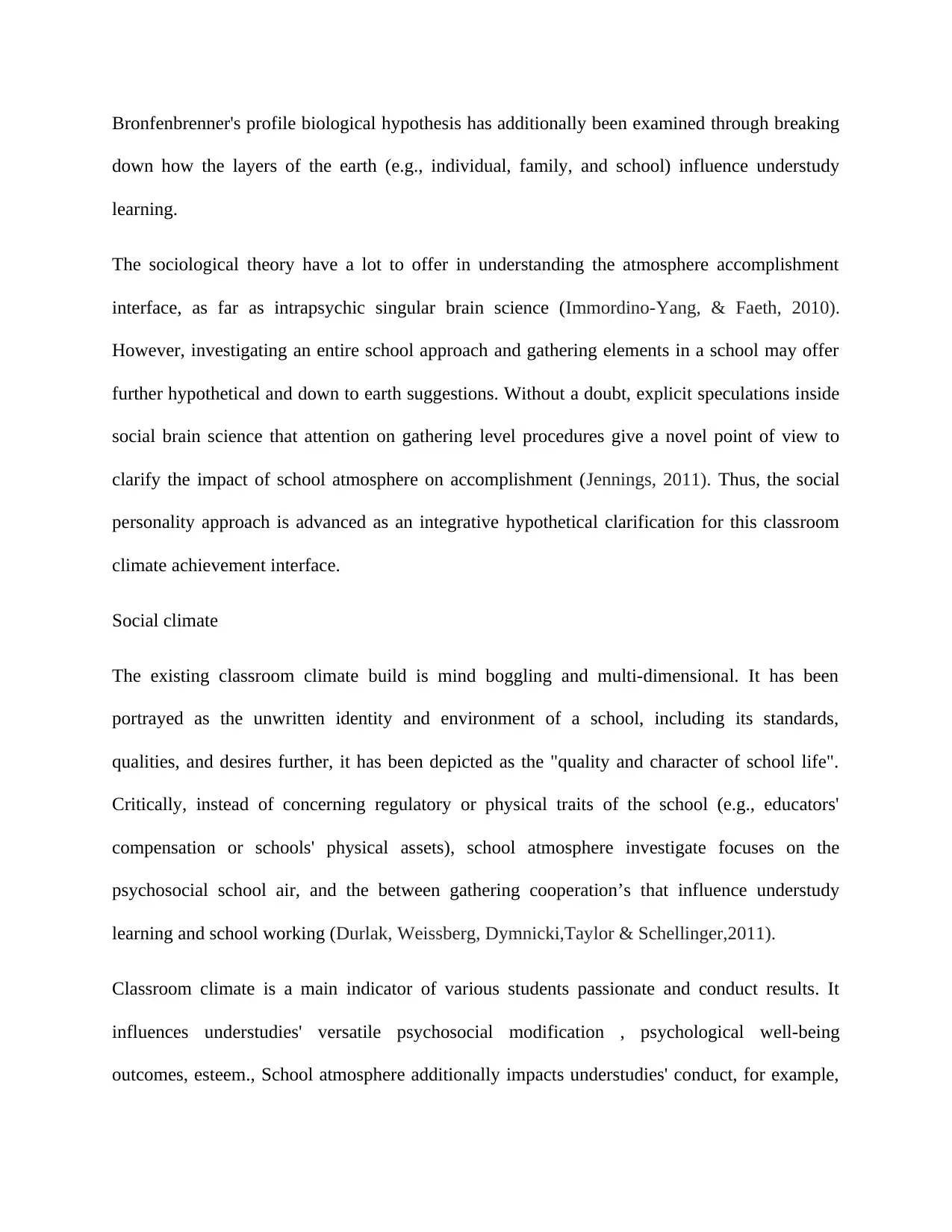
Bronfenbrenner's profile biological hypothesis has additionally been examined through breaking
down how the layers of the earth (e.g., individual, family, and school) influence understudy
learning.
The sociological theory have a lot to offer in understanding the atmosphere accomplishment
interface, as far as intrapsychic singular brain science (Immordino-Yang, & Faeth, 2010).
However, investigating an entire school approach and gathering elements in a school may offer
further hypothetical and down to earth suggestions. Without a doubt, explicit speculations inside
social brain science that attention on gathering level procedures give a novel point of view to
clarify the impact of school atmosphere on accomplishment (Jennings, 2011). Thus, the social
personality approach is advanced as an integrative hypothetical clarification for this classroom
climate achievement interface.
Social climate
The existing classroom climate build is mind boggling and multi-dimensional. It has been
portrayed as the unwritten identity and environment of a school, including its standards,
qualities, and desires further, it has been depicted as the "quality and character of school life".
Critically, instead of concerning regulatory or physical traits of the school (e.g., educators'
compensation or schools' physical assets), school atmosphere investigate focuses on the
psychosocial school air, and the between gathering cooperation’s that influence understudy
learning and school working (Durlak, Weissberg, Dymnicki,Taylor & Schellinger,2011).
Classroom climate is a main indicator of various students passionate and conduct results. It
influences understudies' versatile psychosocial modification , psychological well-being
outcomes, esteem., School atmosphere additionally impacts understudies' conduct, for example,
down how the layers of the earth (e.g., individual, family, and school) influence understudy
learning.
The sociological theory have a lot to offer in understanding the atmosphere accomplishment
interface, as far as intrapsychic singular brain science (Immordino-Yang, & Faeth, 2010).
However, investigating an entire school approach and gathering elements in a school may offer
further hypothetical and down to earth suggestions. Without a doubt, explicit speculations inside
social brain science that attention on gathering level procedures give a novel point of view to
clarify the impact of school atmosphere on accomplishment (Jennings, 2011). Thus, the social
personality approach is advanced as an integrative hypothetical clarification for this classroom
climate achievement interface.
Social climate
The existing classroom climate build is mind boggling and multi-dimensional. It has been
portrayed as the unwritten identity and environment of a school, including its standards,
qualities, and desires further, it has been depicted as the "quality and character of school life".
Critically, instead of concerning regulatory or physical traits of the school (e.g., educators'
compensation or schools' physical assets), school atmosphere investigate focuses on the
psychosocial school air, and the between gathering cooperation’s that influence understudy
learning and school working (Durlak, Weissberg, Dymnicki,Taylor & Schellinger,2011).
Classroom climate is a main indicator of various students passionate and conduct results. It
influences understudies' versatile psychosocial modification , psychological well-being
outcomes, esteem., School atmosphere additionally impacts understudies' conduct, for example,
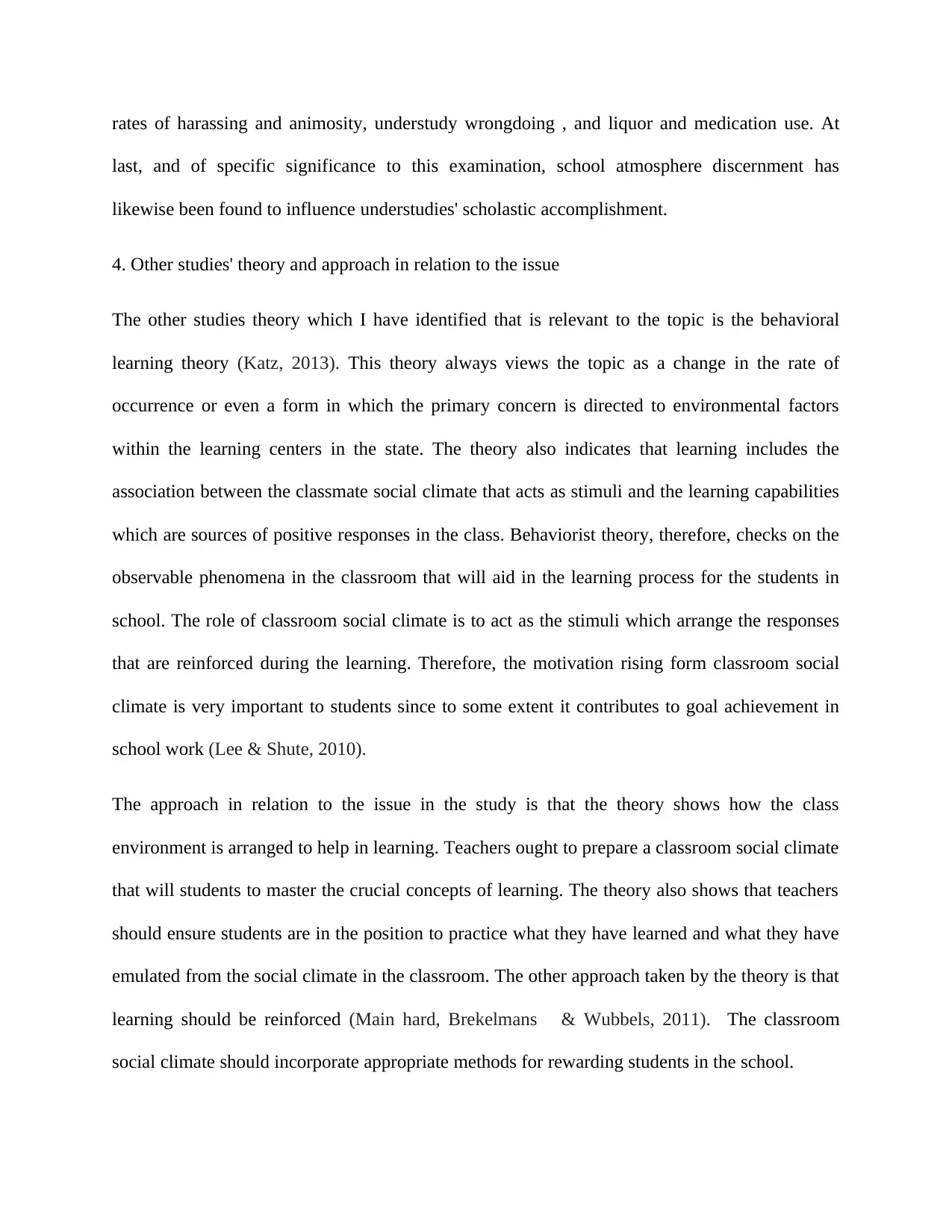
rates of harassing and animosity, understudy wrongdoing , and liquor and medication use. At
last, and of specific significance to this examination, school atmosphere discernment has
likewise been found to influence understudies' scholastic accomplishment.
4. Other studies' theory and approach in relation to the issue
The other studies theory which I have identified that is relevant to the topic is the behavioral
learning theory (Katz, 2013). This theory always views the topic as a change in the rate of
occurrence or even a form in which the primary concern is directed to environmental factors
within the learning centers in the state. The theory also indicates that learning includes the
association between the classmate social climate that acts as stimuli and the learning capabilities
which are sources of positive responses in the class. Behaviorist theory, therefore, checks on the
observable phenomena in the classroom that will aid in the learning process for the students in
school. The role of classroom social climate is to act as the stimuli which arrange the responses
that are reinforced during the learning. Therefore, the motivation rising form classroom social
climate is very important to students since to some extent it contributes to goal achievement in
school work (Lee & Shute, 2010).
The approach in relation to the issue in the study is that the theory shows how the class
environment is arranged to help in learning. Teachers ought to prepare a classroom social climate
that will students to master the crucial concepts of learning. The theory also shows that teachers
should ensure students are in the position to practice what they have learned and what they have
emulated from the social climate in the classroom. The other approach taken by the theory is that
learning should be reinforced (Main hard, Brekelmans & Wubbels, 2011). The classroom
social climate should incorporate appropriate methods for rewarding students in the school.
last, and of specific significance to this examination, school atmosphere discernment has
likewise been found to influence understudies' scholastic accomplishment.
4. Other studies' theory and approach in relation to the issue
The other studies theory which I have identified that is relevant to the topic is the behavioral
learning theory (Katz, 2013). This theory always views the topic as a change in the rate of
occurrence or even a form in which the primary concern is directed to environmental factors
within the learning centers in the state. The theory also indicates that learning includes the
association between the classmate social climate that acts as stimuli and the learning capabilities
which are sources of positive responses in the class. Behaviorist theory, therefore, checks on the
observable phenomena in the classroom that will aid in the learning process for the students in
school. The role of classroom social climate is to act as the stimuli which arrange the responses
that are reinforced during the learning. Therefore, the motivation rising form classroom social
climate is very important to students since to some extent it contributes to goal achievement in
school work (Lee & Shute, 2010).
The approach in relation to the issue in the study is that the theory shows how the class
environment is arranged to help in learning. Teachers ought to prepare a classroom social climate
that will students to master the crucial concepts of learning. The theory also shows that teachers
should ensure students are in the position to practice what they have learned and what they have
emulated from the social climate in the classroom. The other approach taken by the theory is that
learning should be reinforced (Main hard, Brekelmans & Wubbels, 2011). The classroom
social climate should incorporate appropriate methods for rewarding students in the school.
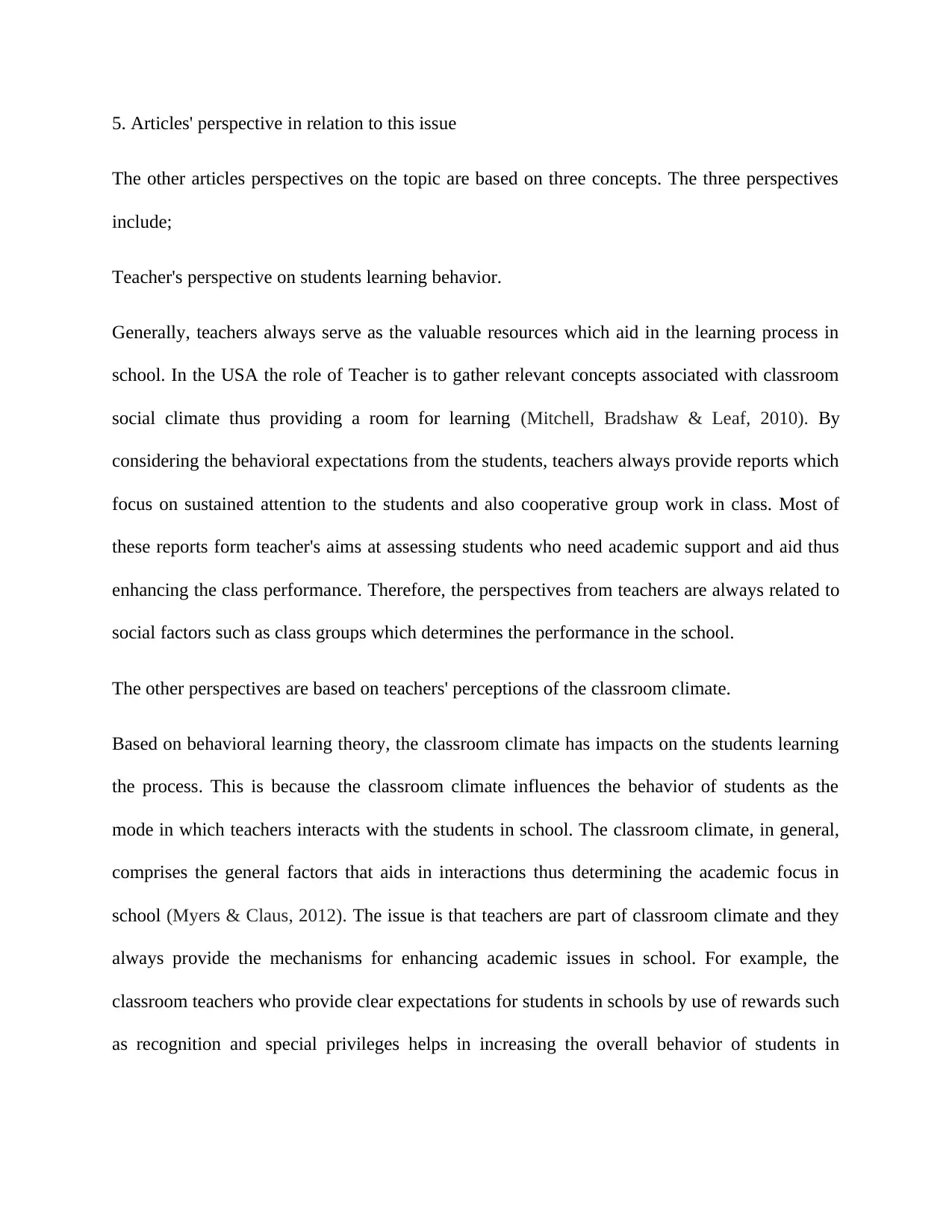
5. Articles' perspective in relation to this issue
The other articles perspectives on the topic are based on three concepts. The three perspectives
include;
Teacher's perspective on students learning behavior.
Generally, teachers always serve as the valuable resources which aid in the learning process in
school. In the USA the role of Teacher is to gather relevant concepts associated with classroom
social climate thus providing a room for learning (Mitchell, Bradshaw & Leaf, 2010). By
considering the behavioral expectations from the students, teachers always provide reports which
focus on sustained attention to the students and also cooperative group work in class. Most of
these reports form teacher's aims at assessing students who need academic support and aid thus
enhancing the class performance. Therefore, the perspectives from teachers are always related to
social factors such as class groups which determines the performance in the school.
The other perspectives are based on teachers' perceptions of the classroom climate.
Based on behavioral learning theory, the classroom climate has impacts on the students learning
the process. This is because the classroom climate influences the behavior of students as the
mode in which teachers interacts with the students in school. The classroom climate, in general,
comprises the general factors that aids in interactions thus determining the academic focus in
school (Myers & Claus, 2012). The issue is that teachers are part of classroom climate and they
always provide the mechanisms for enhancing academic issues in school. For example, the
classroom teachers who provide clear expectations for students in schools by use of rewards such
as recognition and special privileges helps in increasing the overall behavior of students in
The other articles perspectives on the topic are based on three concepts. The three perspectives
include;
Teacher's perspective on students learning behavior.
Generally, teachers always serve as the valuable resources which aid in the learning process in
school. In the USA the role of Teacher is to gather relevant concepts associated with classroom
social climate thus providing a room for learning (Mitchell, Bradshaw & Leaf, 2010). By
considering the behavioral expectations from the students, teachers always provide reports which
focus on sustained attention to the students and also cooperative group work in class. Most of
these reports form teacher's aims at assessing students who need academic support and aid thus
enhancing the class performance. Therefore, the perspectives from teachers are always related to
social factors such as class groups which determines the performance in the school.
The other perspectives are based on teachers' perceptions of the classroom climate.
Based on behavioral learning theory, the classroom climate has impacts on the students learning
the process. This is because the classroom climate influences the behavior of students as the
mode in which teachers interacts with the students in school. The classroom climate, in general,
comprises the general factors that aids in interactions thus determining the academic focus in
school (Myers & Claus, 2012). The issue is that teachers are part of classroom climate and they
always provide the mechanisms for enhancing academic issues in school. For example, the
classroom teachers who provide clear expectations for students in schools by use of rewards such
as recognition and special privileges helps in increasing the overall behavior of students in
Paraphrase This Document
Need a fresh take? Get an instant paraphrase of this document with our AI Paraphraser
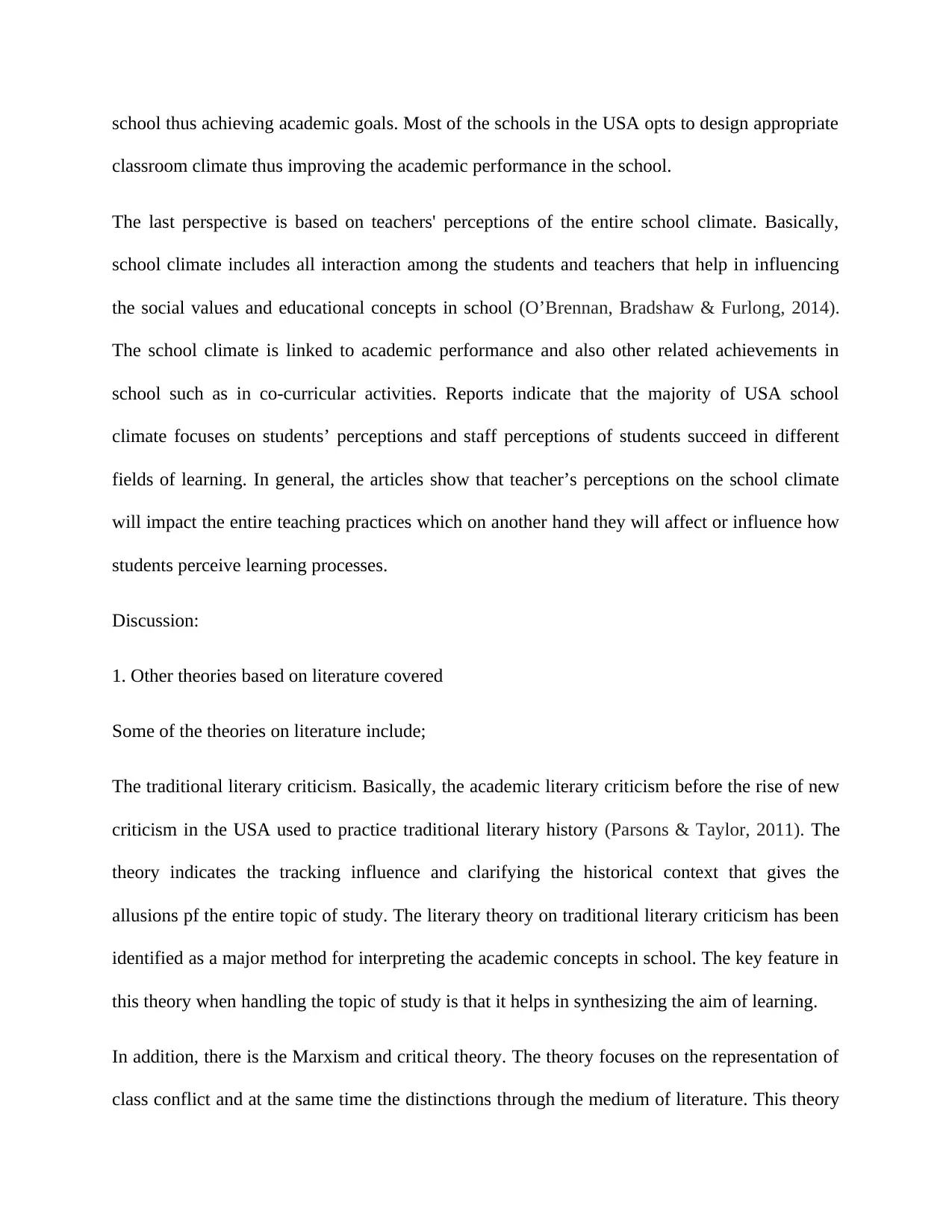
school thus achieving academic goals. Most of the schools in the USA opts to design appropriate
classroom climate thus improving the academic performance in the school.
The last perspective is based on teachers' perceptions of the entire school climate. Basically,
school climate includes all interaction among the students and teachers that help in influencing
the social values and educational concepts in school (O’Brennan, Bradshaw & Furlong, 2014).
The school climate is linked to academic performance and also other related achievements in
school such as in co-curricular activities. Reports indicate that the majority of USA school
climate focuses on students’ perceptions and staff perceptions of students succeed in different
fields of learning. In general, the articles show that teacher’s perceptions on the school climate
will impact the entire teaching practices which on another hand they will affect or influence how
students perceive learning processes.
Discussion:
1. Other theories based on literature covered
Some of the theories on literature include;
The traditional literary criticism. Basically, the academic literary criticism before the rise of new
criticism in the USA used to practice traditional literary history (Parsons & Taylor, 2011). The
theory indicates the tracking influence and clarifying the historical context that gives the
allusions pf the entire topic of study. The literary theory on traditional literary criticism has been
identified as a major method for interpreting the academic concepts in school. The key feature in
this theory when handling the topic of study is that it helps in synthesizing the aim of learning.
In addition, there is the Marxism and critical theory. The theory focuses on the representation of
class conflict and at the same time the distinctions through the medium of literature. This theory
classroom climate thus improving the academic performance in the school.
The last perspective is based on teachers' perceptions of the entire school climate. Basically,
school climate includes all interaction among the students and teachers that help in influencing
the social values and educational concepts in school (O’Brennan, Bradshaw & Furlong, 2014).
The school climate is linked to academic performance and also other related achievements in
school such as in co-curricular activities. Reports indicate that the majority of USA school
climate focuses on students’ perceptions and staff perceptions of students succeed in different
fields of learning. In general, the articles show that teacher’s perceptions on the school climate
will impact the entire teaching practices which on another hand they will affect or influence how
students perceive learning processes.
Discussion:
1. Other theories based on literature covered
Some of the theories on literature include;
The traditional literary criticism. Basically, the academic literary criticism before the rise of new
criticism in the USA used to practice traditional literary history (Parsons & Taylor, 2011). The
theory indicates the tracking influence and clarifying the historical context that gives the
allusions pf the entire topic of study. The literary theory on traditional literary criticism has been
identified as a major method for interpreting the academic concepts in school. The key feature in
this theory when handling the topic of study is that it helps in synthesizing the aim of learning.
In addition, there is the Marxism and critical theory. The theory focuses on the representation of
class conflict and at the same time the distinctions through the medium of literature. This theory
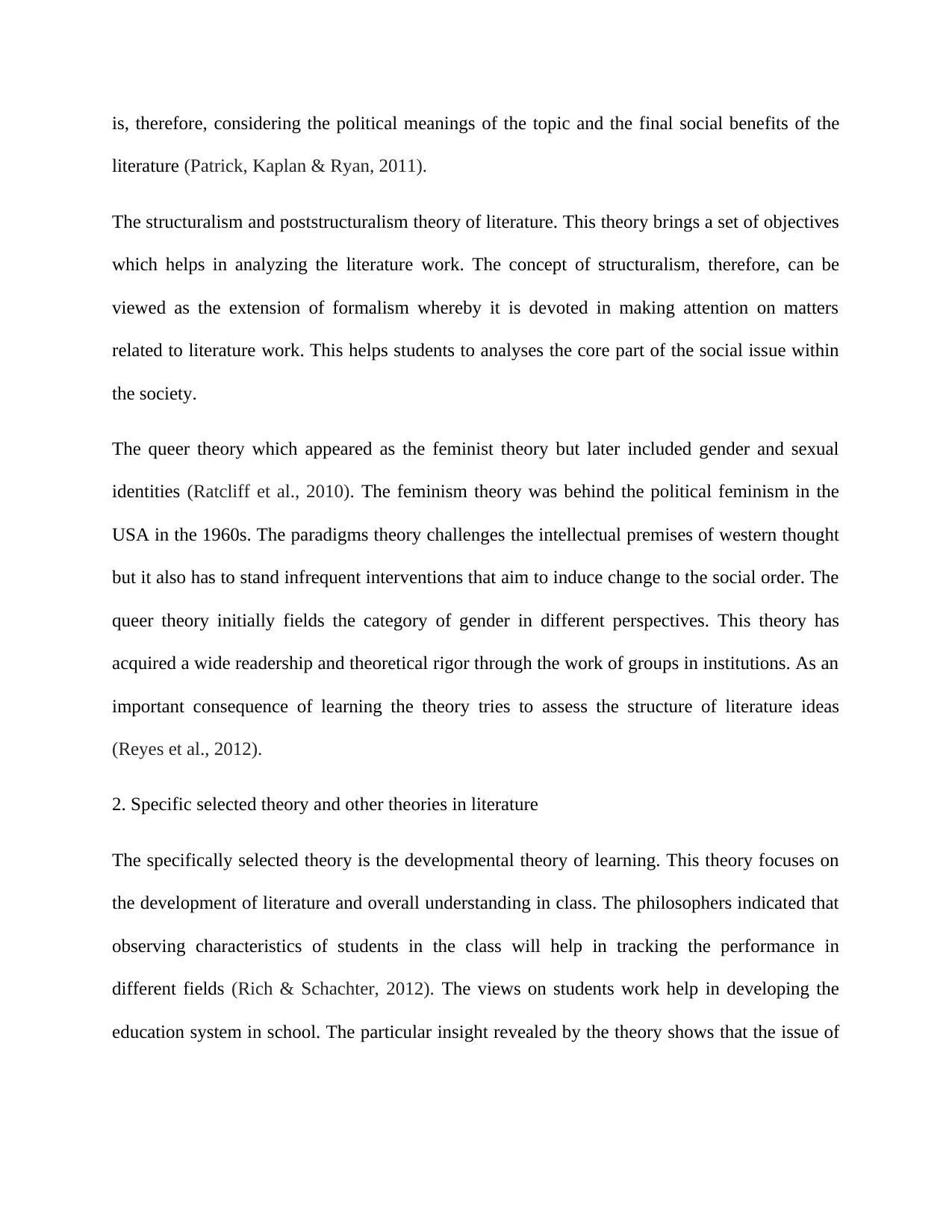
is, therefore, considering the political meanings of the topic and the final social benefits of the
literature (Patrick, Kaplan & Ryan, 2011).
The structuralism and poststructuralism theory of literature. This theory brings a set of objectives
which helps in analyzing the literature work. The concept of structuralism, therefore, can be
viewed as the extension of formalism whereby it is devoted in making attention on matters
related to literature work. This helps students to analyses the core part of the social issue within
the society.
The queer theory which appeared as the feminist theory but later included gender and sexual
identities (Ratcliff et al., 2010). The feminism theory was behind the political feminism in the
USA in the 1960s. The paradigms theory challenges the intellectual premises of western thought
but it also has to stand infrequent interventions that aim to induce change to the social order. The
queer theory initially fields the category of gender in different perspectives. This theory has
acquired a wide readership and theoretical rigor through the work of groups in institutions. As an
important consequence of learning the theory tries to assess the structure of literature ideas
(Reyes et al., 2012).
2. Specific selected theory and other theories in literature
The specifically selected theory is the developmental theory of learning. This theory focuses on
the development of literature and overall understanding in class. The philosophers indicated that
observing characteristics of students in the class will help in tracking the performance in
different fields (Rich & Schachter, 2012). The views on students work help in developing the
education system in school. The particular insight revealed by the theory shows that the issue of
literature (Patrick, Kaplan & Ryan, 2011).
The structuralism and poststructuralism theory of literature. This theory brings a set of objectives
which helps in analyzing the literature work. The concept of structuralism, therefore, can be
viewed as the extension of formalism whereby it is devoted in making attention on matters
related to literature work. This helps students to analyses the core part of the social issue within
the society.
The queer theory which appeared as the feminist theory but later included gender and sexual
identities (Ratcliff et al., 2010). The feminism theory was behind the political feminism in the
USA in the 1960s. The paradigms theory challenges the intellectual premises of western thought
but it also has to stand infrequent interventions that aim to induce change to the social order. The
queer theory initially fields the category of gender in different perspectives. This theory has
acquired a wide readership and theoretical rigor through the work of groups in institutions. As an
important consequence of learning the theory tries to assess the structure of literature ideas
(Reyes et al., 2012).
2. Specific selected theory and other theories in literature
The specifically selected theory is the developmental theory of learning. This theory focuses on
the development of literature and overall understanding in class. The philosophers indicated that
observing characteristics of students in the class will help in tracking the performance in
different fields (Rich & Schachter, 2012). The views on students work help in developing the
education system in school. The particular insight revealed by the theory shows that the issue of
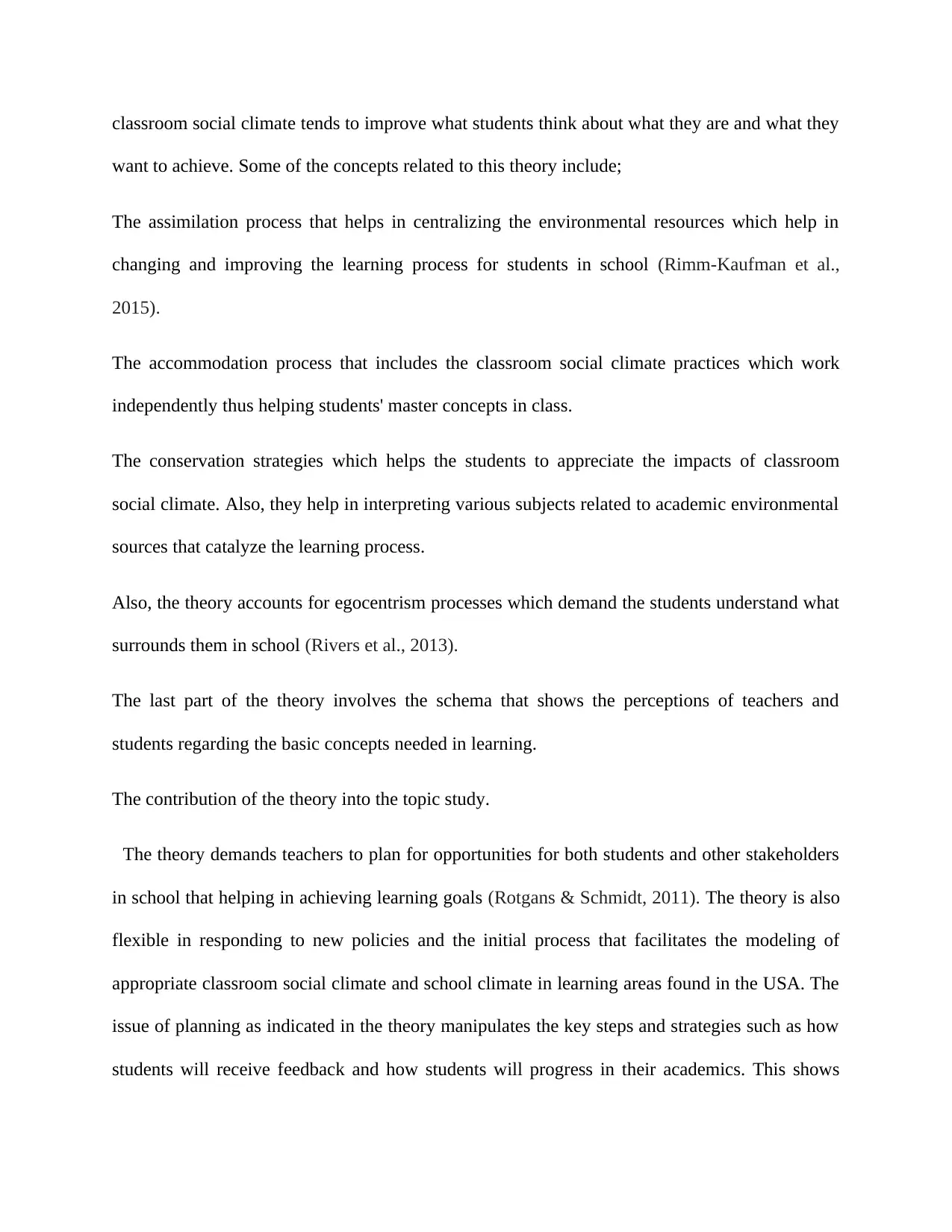
classroom social climate tends to improve what students think about what they are and what they
want to achieve. Some of the concepts related to this theory include;
The assimilation process that helps in centralizing the environmental resources which help in
changing and improving the learning process for students in school (Rimm-Kaufman et al.,
2015).
The accommodation process that includes the classroom social climate practices which work
independently thus helping students' master concepts in class.
The conservation strategies which helps the students to appreciate the impacts of classroom
social climate. Also, they help in interpreting various subjects related to academic environmental
sources that catalyze the learning process.
Also, the theory accounts for egocentrism processes which demand the students understand what
surrounds them in school (Rivers et al., 2013).
The last part of the theory involves the schema that shows the perceptions of teachers and
students regarding the basic concepts needed in learning.
The contribution of the theory into the topic study.
The theory demands teachers to plan for opportunities for both students and other stakeholders
in school that helping in achieving learning goals (Rotgans & Schmidt, 2011). The theory is also
flexible in responding to new policies and the initial process that facilitates the modeling of
appropriate classroom social climate and school climate in learning areas found in the USA. The
issue of planning as indicated in the theory manipulates the key steps and strategies such as how
students will receive feedback and how students will progress in their academics. This shows
want to achieve. Some of the concepts related to this theory include;
The assimilation process that helps in centralizing the environmental resources which help in
changing and improving the learning process for students in school (Rimm-Kaufman et al.,
2015).
The accommodation process that includes the classroom social climate practices which work
independently thus helping students' master concepts in class.
The conservation strategies which helps the students to appreciate the impacts of classroom
social climate. Also, they help in interpreting various subjects related to academic environmental
sources that catalyze the learning process.
Also, the theory accounts for egocentrism processes which demand the students understand what
surrounds them in school (Rivers et al., 2013).
The last part of the theory involves the schema that shows the perceptions of teachers and
students regarding the basic concepts needed in learning.
The contribution of the theory into the topic study.
The theory demands teachers to plan for opportunities for both students and other stakeholders
in school that helping in achieving learning goals (Rotgans & Schmidt, 2011). The theory is also
flexible in responding to new policies and the initial process that facilitates the modeling of
appropriate classroom social climate and school climate in learning areas found in the USA. The
issue of planning as indicated in the theory manipulates the key steps and strategies such as how
students will receive feedback and how students will progress in their academics. This shows
Secure Best Marks with AI Grader
Need help grading? Try our AI Grader for instant feedback on your assignments.
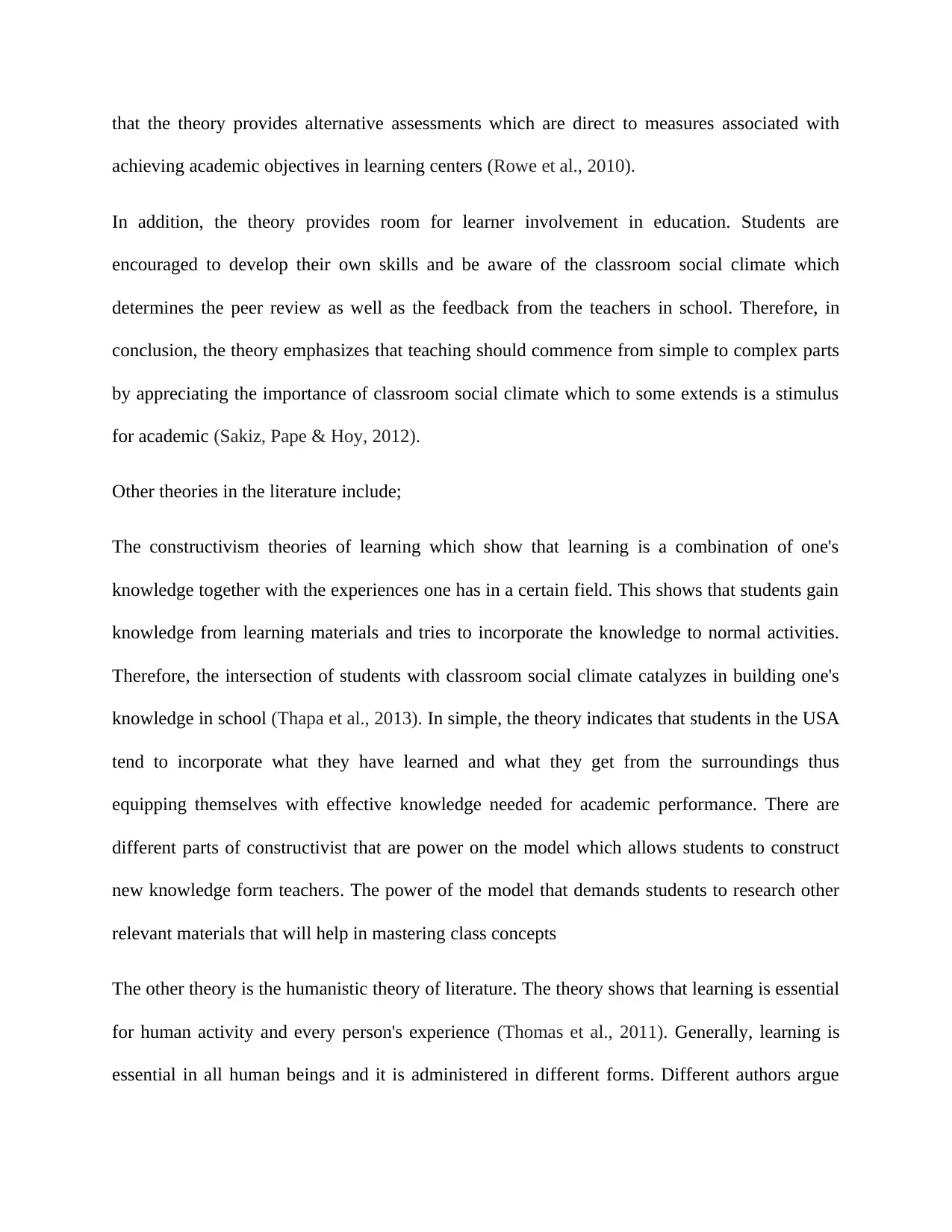
that the theory provides alternative assessments which are direct to measures associated with
achieving academic objectives in learning centers (Rowe et al., 2010).
In addition, the theory provides room for learner involvement in education. Students are
encouraged to develop their own skills and be aware of the classroom social climate which
determines the peer review as well as the feedback from the teachers in school. Therefore, in
conclusion, the theory emphasizes that teaching should commence from simple to complex parts
by appreciating the importance of classroom social climate which to some extends is a stimulus
for academic (Sakiz, Pape & Hoy, 2012).
Other theories in the literature include;
The constructivism theories of learning which show that learning is a combination of one's
knowledge together with the experiences one has in a certain field. This shows that students gain
knowledge from learning materials and tries to incorporate the knowledge to normal activities.
Therefore, the intersection of students with classroom social climate catalyzes in building one's
knowledge in school (Thapa et al., 2013). In simple, the theory indicates that students in the USA
tend to incorporate what they have learned and what they get from the surroundings thus
equipping themselves with effective knowledge needed for academic performance. There are
different parts of constructivist that are power on the model which allows students to construct
new knowledge form teachers. The power of the model that demands students to research other
relevant materials that will help in mastering class concepts
The other theory is the humanistic theory of literature. The theory shows that learning is essential
for human activity and every person's experience (Thomas et al., 2011). Generally, learning is
essential in all human beings and it is administered in different forms. Different authors argue
achieving academic objectives in learning centers (Rowe et al., 2010).
In addition, the theory provides room for learner involvement in education. Students are
encouraged to develop their own skills and be aware of the classroom social climate which
determines the peer review as well as the feedback from the teachers in school. Therefore, in
conclusion, the theory emphasizes that teaching should commence from simple to complex parts
by appreciating the importance of classroom social climate which to some extends is a stimulus
for academic (Sakiz, Pape & Hoy, 2012).
Other theories in the literature include;
The constructivism theories of learning which show that learning is a combination of one's
knowledge together with the experiences one has in a certain field. This shows that students gain
knowledge from learning materials and tries to incorporate the knowledge to normal activities.
Therefore, the intersection of students with classroom social climate catalyzes in building one's
knowledge in school (Thapa et al., 2013). In simple, the theory indicates that students in the USA
tend to incorporate what they have learned and what they get from the surroundings thus
equipping themselves with effective knowledge needed for academic performance. There are
different parts of constructivist that are power on the model which allows students to construct
new knowledge form teachers. The power of the model that demands students to research other
relevant materials that will help in mastering class concepts
The other theory is the humanistic theory of literature. The theory shows that learning is essential
for human activity and every person's experience (Thomas et al., 2011). Generally, learning is
essential in all human beings and it is administered in different forms. Different authors argue
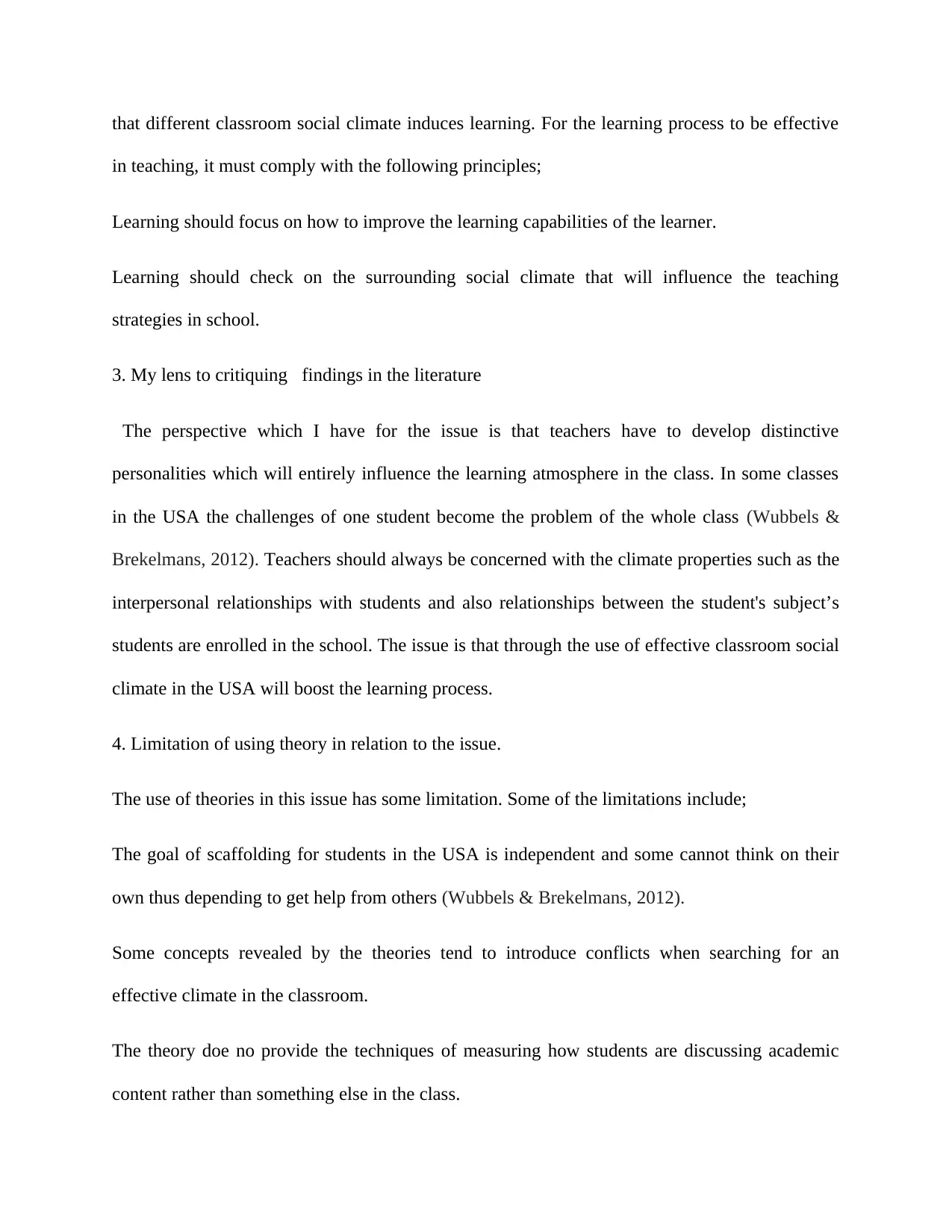
that different classroom social climate induces learning. For the learning process to be effective
in teaching, it must comply with the following principles;
Learning should focus on how to improve the learning capabilities of the learner.
Learning should check on the surrounding social climate that will influence the teaching
strategies in school.
3. My lens to critiquing findings in the literature
The perspective which I have for the issue is that teachers have to develop distinctive
personalities which will entirely influence the learning atmosphere in the class. In some classes
in the USA the challenges of one student become the problem of the whole class (Wubbels &
Brekelmans, 2012). Teachers should always be concerned with the climate properties such as the
interpersonal relationships with students and also relationships between the student's subject’s
students are enrolled in the school. The issue is that through the use of effective classroom social
climate in the USA will boost the learning process.
4. Limitation of using theory in relation to the issue.
The use of theories in this issue has some limitation. Some of the limitations include;
The goal of scaffolding for students in the USA is independent and some cannot think on their
own thus depending to get help from others (Wubbels & Brekelmans, 2012).
Some concepts revealed by the theories tend to introduce conflicts when searching for an
effective climate in the classroom.
The theory doe no provide the techniques of measuring how students are discussing academic
content rather than something else in the class.
in teaching, it must comply with the following principles;
Learning should focus on how to improve the learning capabilities of the learner.
Learning should check on the surrounding social climate that will influence the teaching
strategies in school.
3. My lens to critiquing findings in the literature
The perspective which I have for the issue is that teachers have to develop distinctive
personalities which will entirely influence the learning atmosphere in the class. In some classes
in the USA the challenges of one student become the problem of the whole class (Wubbels &
Brekelmans, 2012). Teachers should always be concerned with the climate properties such as the
interpersonal relationships with students and also relationships between the student's subject’s
students are enrolled in the school. The issue is that through the use of effective classroom social
climate in the USA will boost the learning process.
4. Limitation of using theory in relation to the issue.
The use of theories in this issue has some limitation. Some of the limitations include;
The goal of scaffolding for students in the USA is independent and some cannot think on their
own thus depending to get help from others (Wubbels & Brekelmans, 2012).
Some concepts revealed by the theories tend to introduce conflicts when searching for an
effective climate in the classroom.
The theory doe no provide the techniques of measuring how students are discussing academic
content rather than something else in the class.
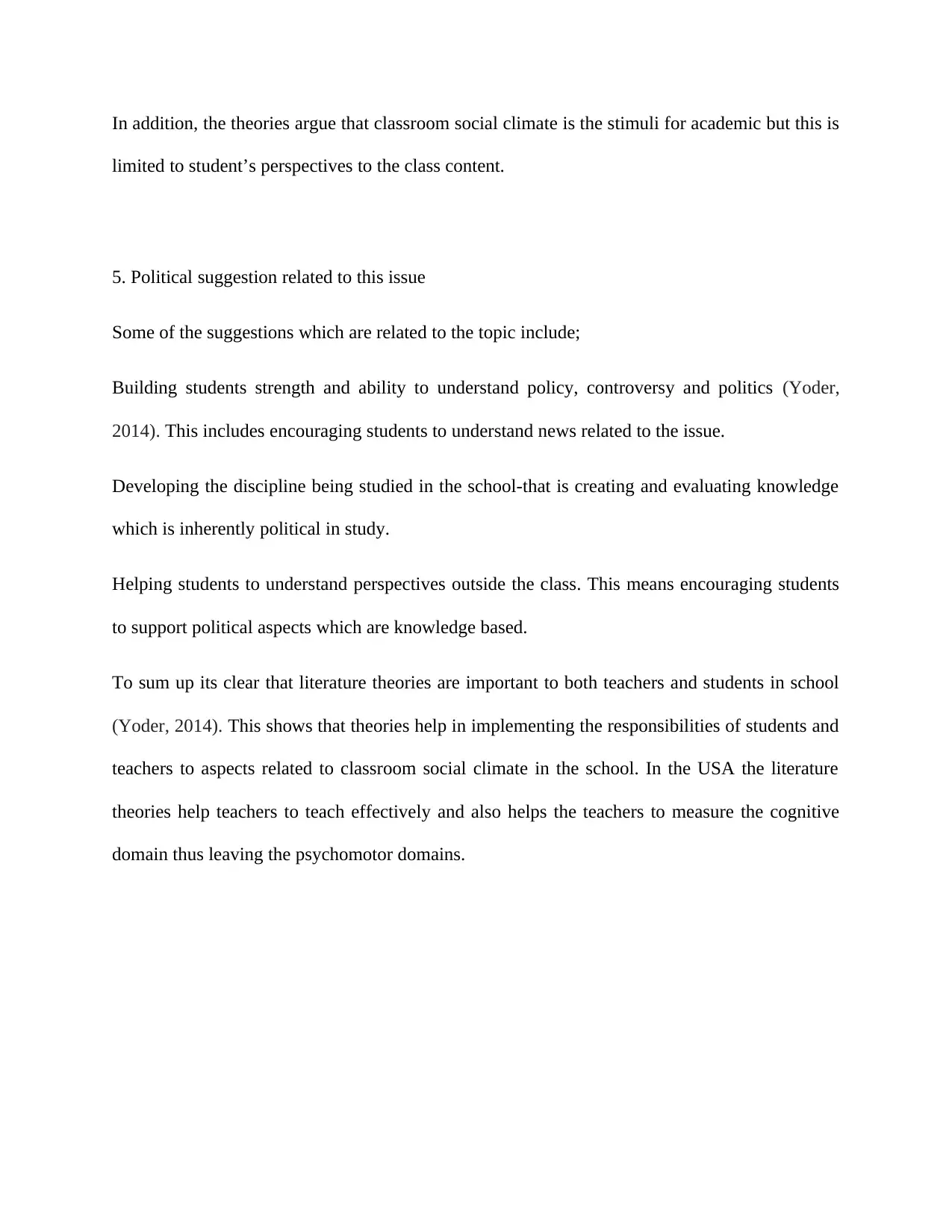
In addition, the theories argue that classroom social climate is the stimuli for academic but this is
limited to student’s perspectives to the class content.
5. Political suggestion related to this issue
Some of the suggestions which are related to the topic include;
Building students strength and ability to understand policy, controversy and politics (Yoder,
2014). This includes encouraging students to understand news related to the issue.
Developing the discipline being studied in the school-that is creating and evaluating knowledge
which is inherently political in study.
Helping students to understand perspectives outside the class. This means encouraging students
to support political aspects which are knowledge based.
To sum up its clear that literature theories are important to both teachers and students in school
(Yoder, 2014). This shows that theories help in implementing the responsibilities of students and
teachers to aspects related to classroom social climate in the school. In the USA the literature
theories help teachers to teach effectively and also helps the teachers to measure the cognitive
domain thus leaving the psychomotor domains.
limited to student’s perspectives to the class content.
5. Political suggestion related to this issue
Some of the suggestions which are related to the topic include;
Building students strength and ability to understand policy, controversy and politics (Yoder,
2014). This includes encouraging students to understand news related to the issue.
Developing the discipline being studied in the school-that is creating and evaluating knowledge
which is inherently political in study.
Helping students to understand perspectives outside the class. This means encouraging students
to support political aspects which are knowledge based.
To sum up its clear that literature theories are important to both teachers and students in school
(Yoder, 2014). This shows that theories help in implementing the responsibilities of students and
teachers to aspects related to classroom social climate in the school. In the USA the literature
theories help teachers to teach effectively and also helps the teachers to measure the cognitive
domain thus leaving the psychomotor domains.
Paraphrase This Document
Need a fresh take? Get an instant paraphrase of this document with our AI Paraphraser
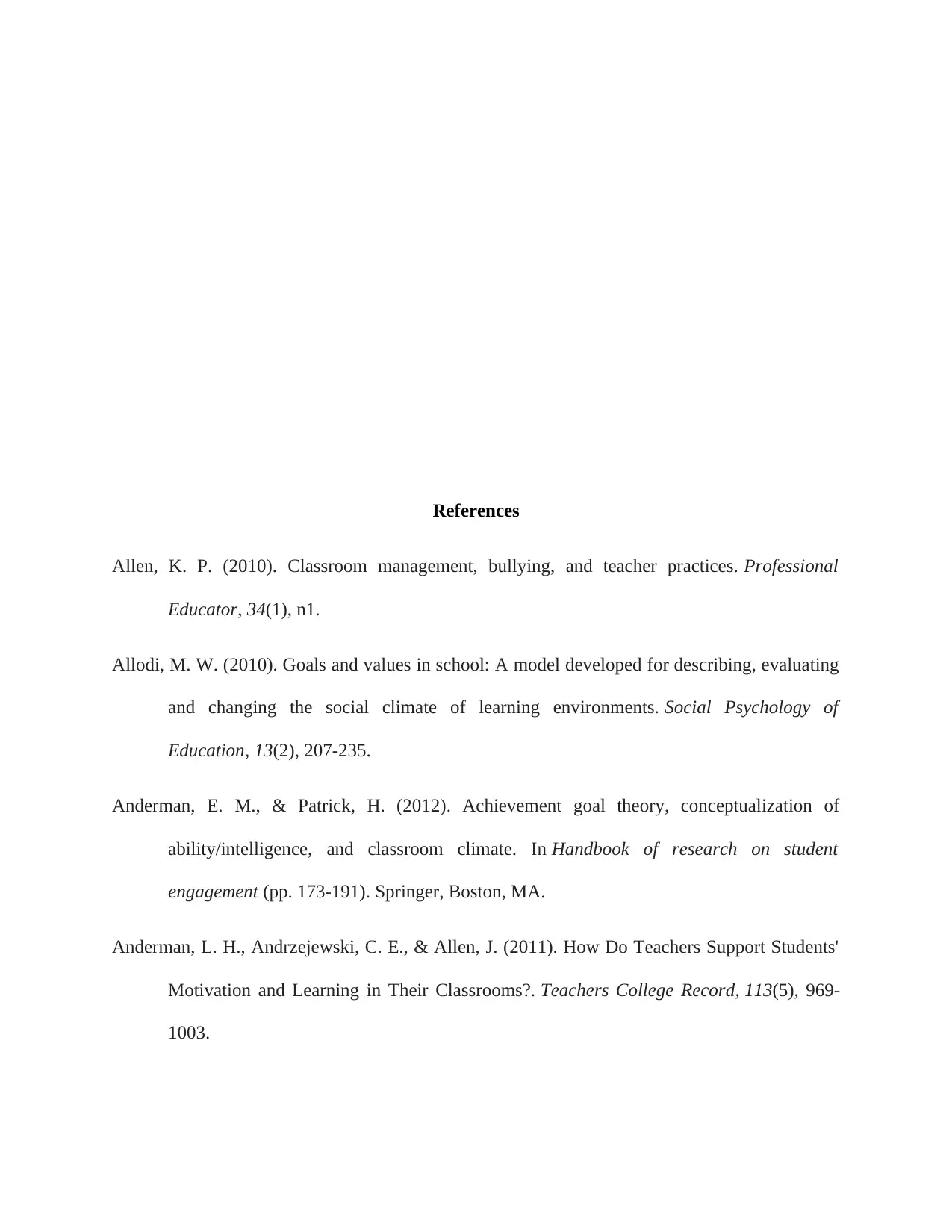
References
Allen, K. P. (2010). Classroom management, bullying, and teacher practices. Professional
Educator, 34(1), n1.
Allodi, M. W. (2010). Goals and values in school: A model developed for describing, evaluating
and changing the social climate of learning environments. Social Psychology of
Education, 13(2), 207-235.
Anderman, E. M., & Patrick, H. (2012). Achievement goal theory, conceptualization of
ability/intelligence, and classroom climate. In Handbook of research on student
engagement (pp. 173-191). Springer, Boston, MA.
Anderman, L. H., Andrzejewski, C. E., & Allen, J. (2011). How Do Teachers Support Students'
Motivation and Learning in Their Classrooms?. Teachers College Record, 113(5), 969-
1003.
Allen, K. P. (2010). Classroom management, bullying, and teacher practices. Professional
Educator, 34(1), n1.
Allodi, M. W. (2010). Goals and values in school: A model developed for describing, evaluating
and changing the social climate of learning environments. Social Psychology of
Education, 13(2), 207-235.
Anderman, E. M., & Patrick, H. (2012). Achievement goal theory, conceptualization of
ability/intelligence, and classroom climate. In Handbook of research on student
engagement (pp. 173-191). Springer, Boston, MA.
Anderman, L. H., Andrzejewski, C. E., & Allen, J. (2011). How Do Teachers Support Students'
Motivation and Learning in Their Classrooms?. Teachers College Record, 113(5), 969-
1003.
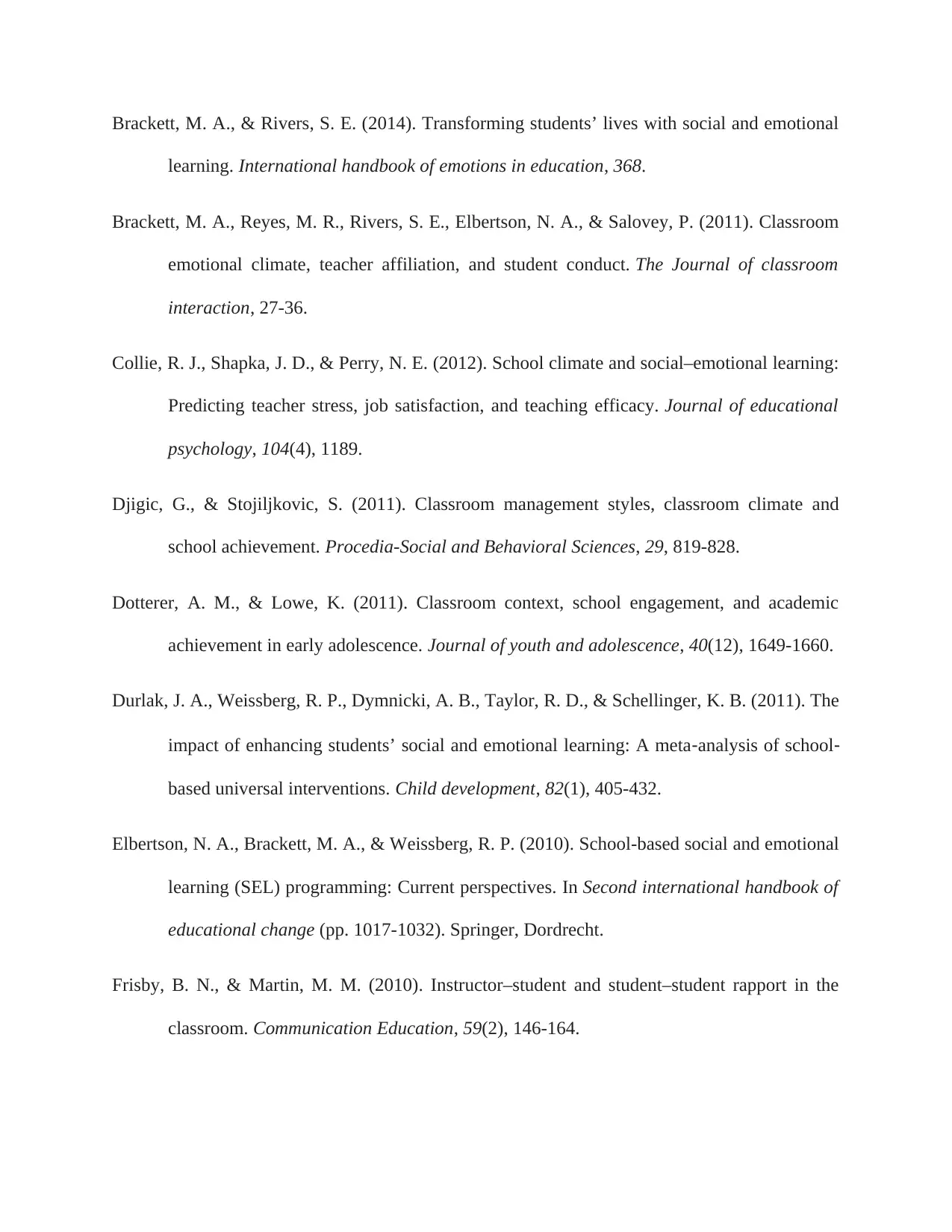
Brackett, M. A., & Rivers, S. E. (2014). Transforming students’ lives with social and emotional
learning. International handbook of emotions in education, 368.
Brackett, M. A., Reyes, M. R., Rivers, S. E., Elbertson, N. A., & Salovey, P. (2011). Classroom
emotional climate, teacher affiliation, and student conduct. The Journal of classroom
interaction, 27-36.
Collie, R. J., Shapka, J. D., & Perry, N. E. (2012). School climate and social–emotional learning:
Predicting teacher stress, job satisfaction, and teaching efficacy. Journal of educational
psychology, 104(4), 1189.
Djigic, G., & Stojiljkovic, S. (2011). Classroom management styles, classroom climate and
school achievement. Procedia-Social and Behavioral Sciences, 29, 819-828.
Dotterer, A. M., & Lowe, K. (2011). Classroom context, school engagement, and academic
achievement in early adolescence. Journal of youth and adolescence, 40(12), 1649-1660.
Durlak, J. A., Weissberg, R. P., Dymnicki, A. B., Taylor, R. D., & Schellinger, K. B. (2011). The
impact of enhancing students’ social and emotional learning: A meta‐analysis of school‐
based universal interventions. Child development, 82(1), 405-432.
Elbertson, N. A., Brackett, M. A., & Weissberg, R. P. (2010). School-based social and emotional
learning (SEL) programming: Current perspectives. In Second international handbook of
educational change (pp. 1017-1032). Springer, Dordrecht.
Frisby, B. N., & Martin, M. M. (2010). Instructor–student and student–student rapport in the
classroom. Communication Education, 59(2), 146-164.
learning. International handbook of emotions in education, 368.
Brackett, M. A., Reyes, M. R., Rivers, S. E., Elbertson, N. A., & Salovey, P. (2011). Classroom
emotional climate, teacher affiliation, and student conduct. The Journal of classroom
interaction, 27-36.
Collie, R. J., Shapka, J. D., & Perry, N. E. (2012). School climate and social–emotional learning:
Predicting teacher stress, job satisfaction, and teaching efficacy. Journal of educational
psychology, 104(4), 1189.
Djigic, G., & Stojiljkovic, S. (2011). Classroom management styles, classroom climate and
school achievement. Procedia-Social and Behavioral Sciences, 29, 819-828.
Dotterer, A. M., & Lowe, K. (2011). Classroom context, school engagement, and academic
achievement in early adolescence. Journal of youth and adolescence, 40(12), 1649-1660.
Durlak, J. A., Weissberg, R. P., Dymnicki, A. B., Taylor, R. D., & Schellinger, K. B. (2011). The
impact of enhancing students’ social and emotional learning: A meta‐analysis of school‐
based universal interventions. Child development, 82(1), 405-432.
Elbertson, N. A., Brackett, M. A., & Weissberg, R. P. (2010). School-based social and emotional
learning (SEL) programming: Current perspectives. In Second international handbook of
educational change (pp. 1017-1032). Springer, Dordrecht.
Frisby, B. N., & Martin, M. M. (2010). Instructor–student and student–student rapport in the
classroom. Communication Education, 59(2), 146-164.
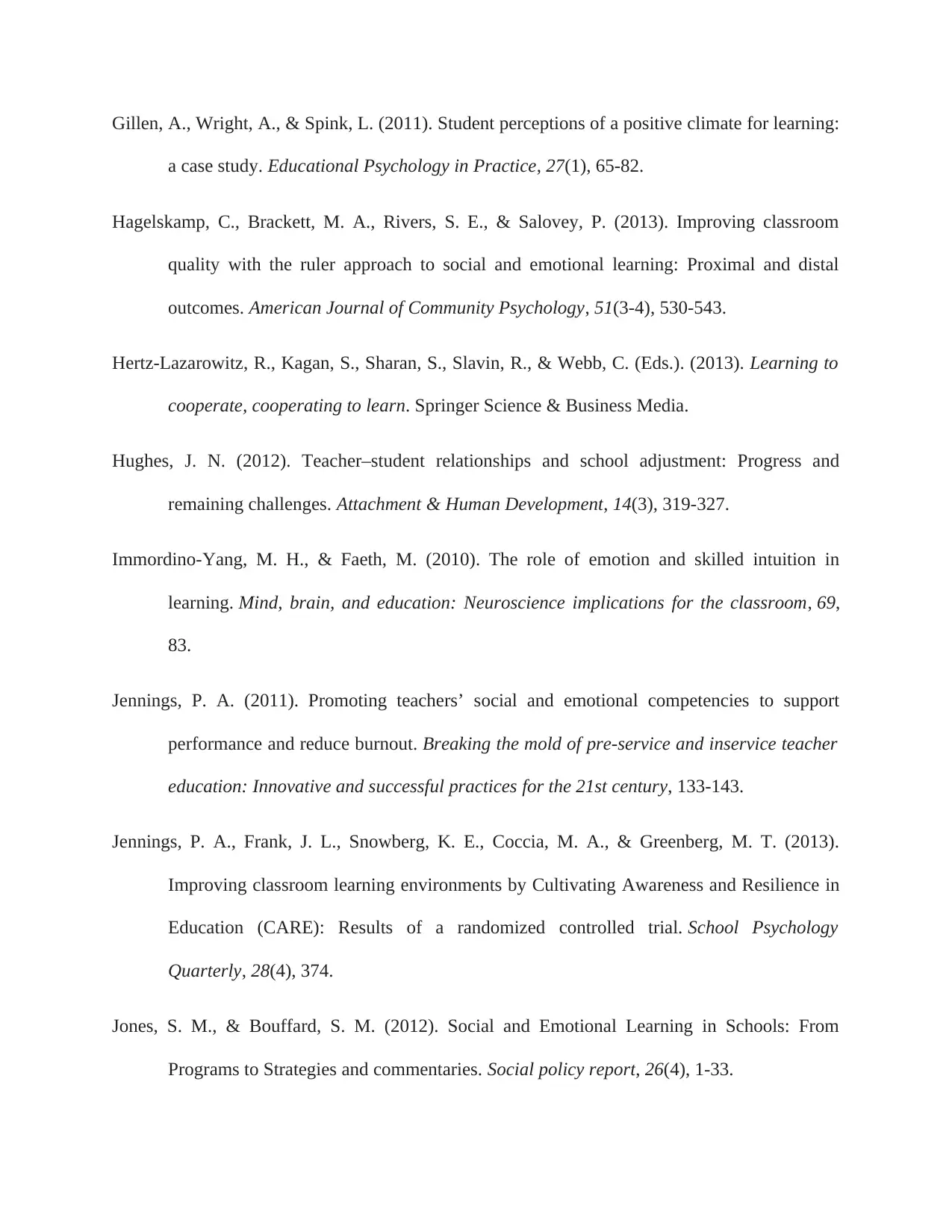
Gillen, A., Wright, A., & Spink, L. (2011). Student perceptions of a positive climate for learning:
a case study. Educational Psychology in Practice, 27(1), 65-82.
Hagelskamp, C., Brackett, M. A., Rivers, S. E., & Salovey, P. (2013). Improving classroom
quality with the ruler approach to social and emotional learning: Proximal and distal
outcomes. American Journal of Community Psychology, 51(3-4), 530-543.
Hertz-Lazarowitz, R., Kagan, S., Sharan, S., Slavin, R., & Webb, C. (Eds.). (2013). Learning to
cooperate, cooperating to learn. Springer Science & Business Media.
Hughes, J. N. (2012). Teacher–student relationships and school adjustment: Progress and
remaining challenges. Attachment & Human Development, 14(3), 319-327.
Immordino-Yang, M. H., & Faeth, M. (2010). The role of emotion and skilled intuition in
learning. Mind, brain, and education: Neuroscience implications for the classroom, 69,
83.
Jennings, P. A. (2011). Promoting teachers’ social and emotional competencies to support
performance and reduce burnout. Breaking the mold of pre-service and inservice teacher
education: Innovative and successful practices for the 21st century, 133-143.
Jennings, P. A., Frank, J. L., Snowberg, K. E., Coccia, M. A., & Greenberg, M. T. (2013).
Improving classroom learning environments by Cultivating Awareness and Resilience in
Education (CARE): Results of a randomized controlled trial. School Psychology
Quarterly, 28(4), 374.
Jones, S. M., & Bouffard, S. M. (2012). Social and Emotional Learning in Schools: From
Programs to Strategies and commentaries. Social policy report, 26(4), 1-33.
a case study. Educational Psychology in Practice, 27(1), 65-82.
Hagelskamp, C., Brackett, M. A., Rivers, S. E., & Salovey, P. (2013). Improving classroom
quality with the ruler approach to social and emotional learning: Proximal and distal
outcomes. American Journal of Community Psychology, 51(3-4), 530-543.
Hertz-Lazarowitz, R., Kagan, S., Sharan, S., Slavin, R., & Webb, C. (Eds.). (2013). Learning to
cooperate, cooperating to learn. Springer Science & Business Media.
Hughes, J. N. (2012). Teacher–student relationships and school adjustment: Progress and
remaining challenges. Attachment & Human Development, 14(3), 319-327.
Immordino-Yang, M. H., & Faeth, M. (2010). The role of emotion and skilled intuition in
learning. Mind, brain, and education: Neuroscience implications for the classroom, 69,
83.
Jennings, P. A. (2011). Promoting teachers’ social and emotional competencies to support
performance and reduce burnout. Breaking the mold of pre-service and inservice teacher
education: Innovative and successful practices for the 21st century, 133-143.
Jennings, P. A., Frank, J. L., Snowberg, K. E., Coccia, M. A., & Greenberg, M. T. (2013).
Improving classroom learning environments by Cultivating Awareness and Resilience in
Education (CARE): Results of a randomized controlled trial. School Psychology
Quarterly, 28(4), 374.
Jones, S. M., & Bouffard, S. M. (2012). Social and Emotional Learning in Schools: From
Programs to Strategies and commentaries. Social policy report, 26(4), 1-33.
Secure Best Marks with AI Grader
Need help grading? Try our AI Grader for instant feedback on your assignments.
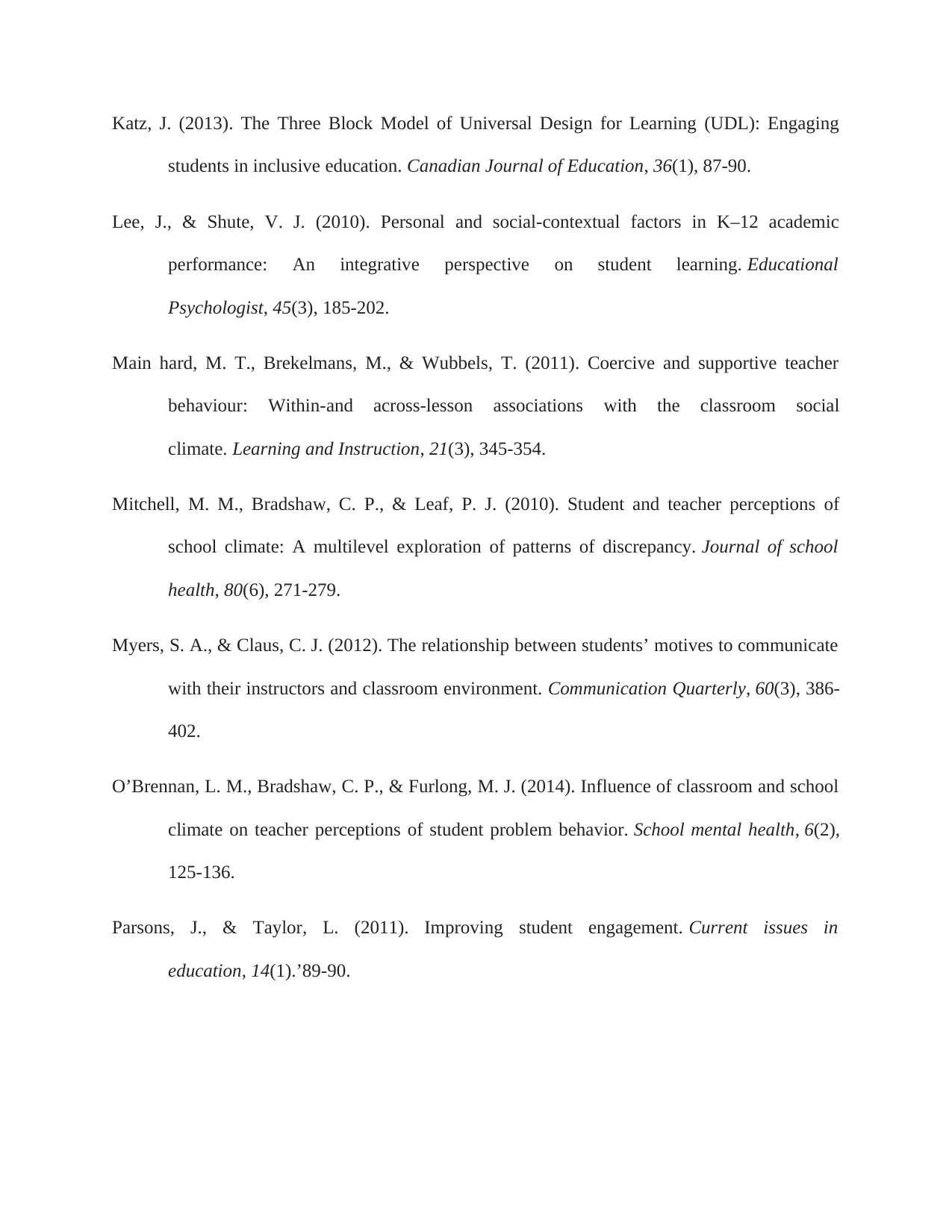
Katz, J. (2013). The Three Block Model of Universal Design for Learning (UDL): Engaging
students in inclusive education. Canadian Journal of Education, 36(1), 87-90.
Lee, J., & Shute, V. J. (2010). Personal and social-contextual factors in K–12 academic
performance: An integrative perspective on student learning. Educational
Psychologist, 45(3), 185-202.
Main hard, M. T., Brekelmans, M., & Wubbels, T. (2011). Coercive and supportive teacher
behaviour: Within-and across-lesson associations with the classroom social
climate. Learning and Instruction, 21(3), 345-354.
Mitchell, M. M., Bradshaw, C. P., & Leaf, P. J. (2010). Student and teacher perceptions of
school climate: A multilevel exploration of patterns of discrepancy. Journal of school
health, 80(6), 271-279.
Myers, S. A., & Claus, C. J. (2012). The relationship between students’ motives to communicate
with their instructors and classroom environment. Communication Quarterly, 60(3), 386-
402.
O’Brennan, L. M., Bradshaw, C. P., & Furlong, M. J. (2014). Influence of classroom and school
climate on teacher perceptions of student problem behavior. School mental health, 6(2),
125-136.
Parsons, J., & Taylor, L. (2011). Improving student engagement. Current issues in
education, 14(1).’89-90.
students in inclusive education. Canadian Journal of Education, 36(1), 87-90.
Lee, J., & Shute, V. J. (2010). Personal and social-contextual factors in K–12 academic
performance: An integrative perspective on student learning. Educational
Psychologist, 45(3), 185-202.
Main hard, M. T., Brekelmans, M., & Wubbels, T. (2011). Coercive and supportive teacher
behaviour: Within-and across-lesson associations with the classroom social
climate. Learning and Instruction, 21(3), 345-354.
Mitchell, M. M., Bradshaw, C. P., & Leaf, P. J. (2010). Student and teacher perceptions of
school climate: A multilevel exploration of patterns of discrepancy. Journal of school
health, 80(6), 271-279.
Myers, S. A., & Claus, C. J. (2012). The relationship between students’ motives to communicate
with their instructors and classroom environment. Communication Quarterly, 60(3), 386-
402.
O’Brennan, L. M., Bradshaw, C. P., & Furlong, M. J. (2014). Influence of classroom and school
climate on teacher perceptions of student problem behavior. School mental health, 6(2),
125-136.
Parsons, J., & Taylor, L. (2011). Improving student engagement. Current issues in
education, 14(1).’89-90.
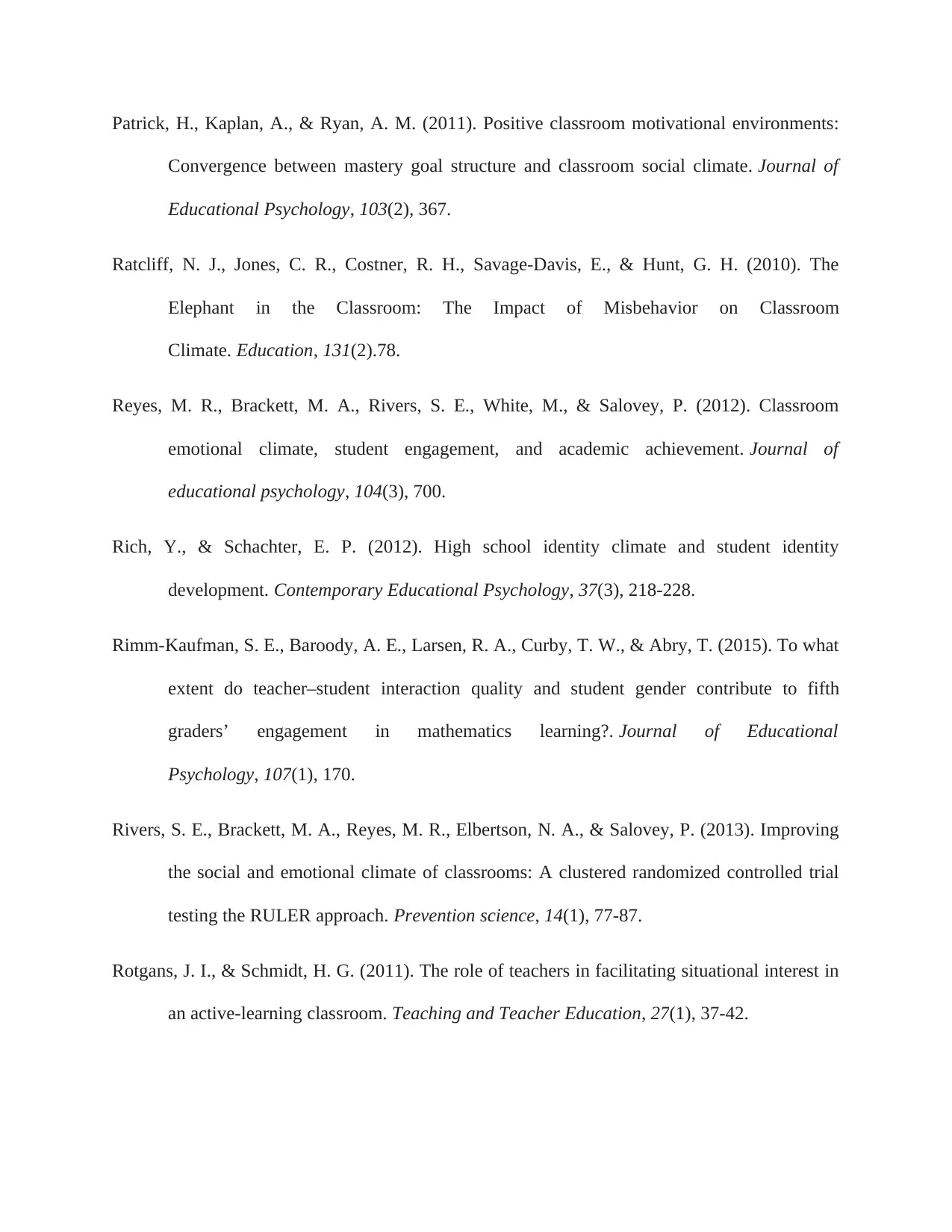
Patrick, H., Kaplan, A., & Ryan, A. M. (2011). Positive classroom motivational environments:
Convergence between mastery goal structure and classroom social climate. Journal of
Educational Psychology, 103(2), 367.
Ratcliff, N. J., Jones, C. R., Costner, R. H., Savage-Davis, E., & Hunt, G. H. (2010). The
Elephant in the Classroom: The Impact of Misbehavior on Classroom
Climate. Education, 131(2).78.
Reyes, M. R., Brackett, M. A., Rivers, S. E., White, M., & Salovey, P. (2012). Classroom
emotional climate, student engagement, and academic achievement. Journal of
educational psychology, 104(3), 700.
Rich, Y., & Schachter, E. P. (2012). High school identity climate and student identity
development. Contemporary Educational Psychology, 37(3), 218-228.
Rimm-Kaufman, S. E., Baroody, A. E., Larsen, R. A., Curby, T. W., & Abry, T. (2015). To what
extent do teacher–student interaction quality and student gender contribute to fifth
graders’ engagement in mathematics learning?. Journal of Educational
Psychology, 107(1), 170.
Rivers, S. E., Brackett, M. A., Reyes, M. R., Elbertson, N. A., & Salovey, P. (2013). Improving
the social and emotional climate of classrooms: A clustered randomized controlled trial
testing the RULER approach. Prevention science, 14(1), 77-87.
Rotgans, J. I., & Schmidt, H. G. (2011). The role of teachers in facilitating situational interest in
an active-learning classroom. Teaching and Teacher Education, 27(1), 37-42.
Convergence between mastery goal structure and classroom social climate. Journal of
Educational Psychology, 103(2), 367.
Ratcliff, N. J., Jones, C. R., Costner, R. H., Savage-Davis, E., & Hunt, G. H. (2010). The
Elephant in the Classroom: The Impact of Misbehavior on Classroom
Climate. Education, 131(2).78.
Reyes, M. R., Brackett, M. A., Rivers, S. E., White, M., & Salovey, P. (2012). Classroom
emotional climate, student engagement, and academic achievement. Journal of
educational psychology, 104(3), 700.
Rich, Y., & Schachter, E. P. (2012). High school identity climate and student identity
development. Contemporary Educational Psychology, 37(3), 218-228.
Rimm-Kaufman, S. E., Baroody, A. E., Larsen, R. A., Curby, T. W., & Abry, T. (2015). To what
extent do teacher–student interaction quality and student gender contribute to fifth
graders’ engagement in mathematics learning?. Journal of Educational
Psychology, 107(1), 170.
Rivers, S. E., Brackett, M. A., Reyes, M. R., Elbertson, N. A., & Salovey, P. (2013). Improving
the social and emotional climate of classrooms: A clustered randomized controlled trial
testing the RULER approach. Prevention science, 14(1), 77-87.
Rotgans, J. I., & Schmidt, H. G. (2011). The role of teachers in facilitating situational interest in
an active-learning classroom. Teaching and Teacher Education, 27(1), 37-42.
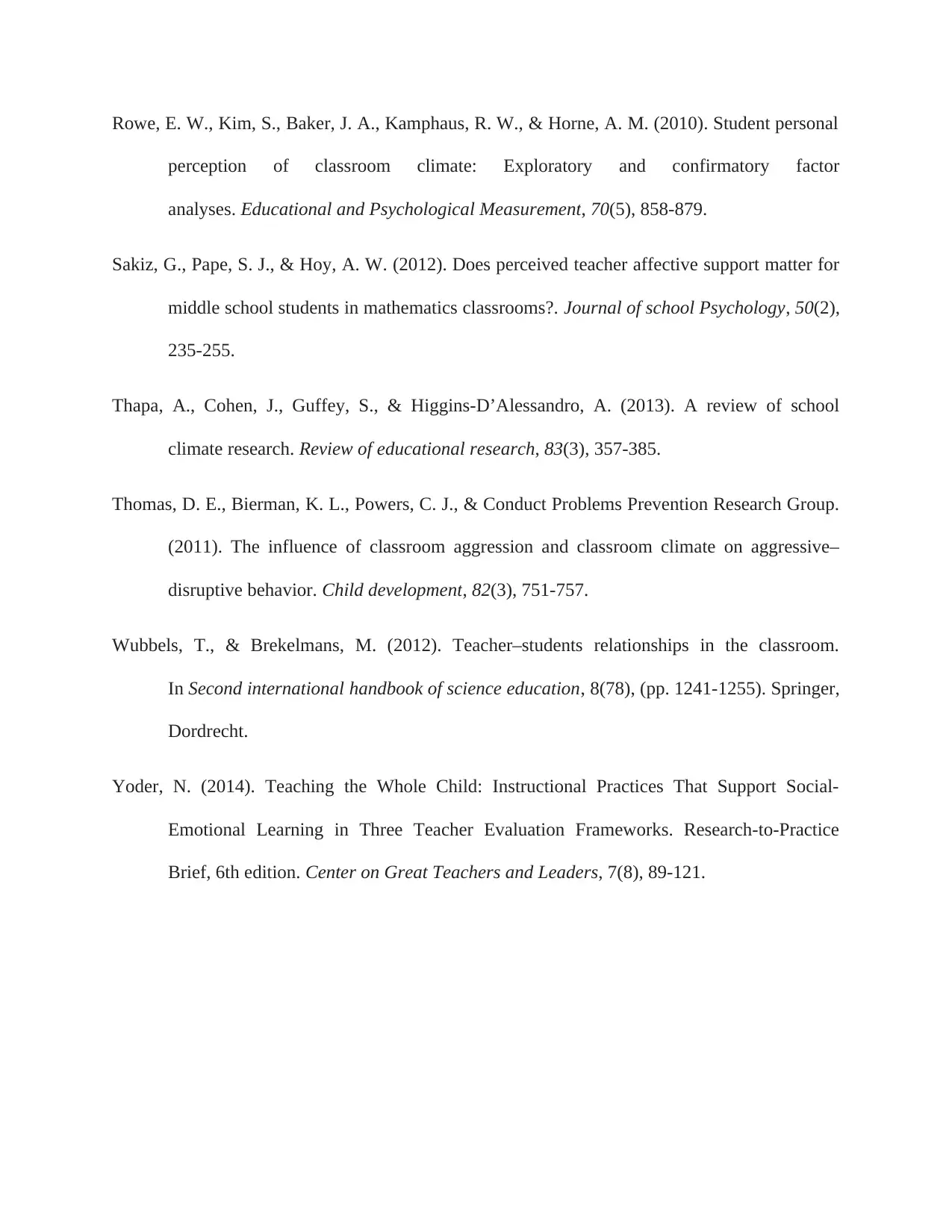
Rowe, E. W., Kim, S., Baker, J. A., Kamphaus, R. W., & Horne, A. M. (2010). Student personal
perception of classroom climate: Exploratory and confirmatory factor
analyses. Educational and Psychological Measurement, 70(5), 858-879.
Sakiz, G., Pape, S. J., & Hoy, A. W. (2012). Does perceived teacher affective support matter for
middle school students in mathematics classrooms?. Journal of school Psychology, 50(2),
235-255.
Thapa, A., Cohen, J., Guffey, S., & Higgins-D’Alessandro, A. (2013). A review of school
climate research. Review of educational research, 83(3), 357-385.
Thomas, D. E., Bierman, K. L., Powers, C. J., & Conduct Problems Prevention Research Group.
(2011). The influence of classroom aggression and classroom climate on aggressive–
disruptive behavior. Child development, 82(3), 751-757.
Wubbels, T., & Brekelmans, M. (2012). Teacher–students relationships in the classroom.
In Second international handbook of science education, 8(78), (pp. 1241-1255). Springer,
Dordrecht.
Yoder, N. (2014). Teaching the Whole Child: Instructional Practices That Support Social-
Emotional Learning in Three Teacher Evaluation Frameworks. Research-to-Practice
Brief, 6th edition. Center on Great Teachers and Leaders, 7(8), 89-121.
perception of classroom climate: Exploratory and confirmatory factor
analyses. Educational and Psychological Measurement, 70(5), 858-879.
Sakiz, G., Pape, S. J., & Hoy, A. W. (2012). Does perceived teacher affective support matter for
middle school students in mathematics classrooms?. Journal of school Psychology, 50(2),
235-255.
Thapa, A., Cohen, J., Guffey, S., & Higgins-D’Alessandro, A. (2013). A review of school
climate research. Review of educational research, 83(3), 357-385.
Thomas, D. E., Bierman, K. L., Powers, C. J., & Conduct Problems Prevention Research Group.
(2011). The influence of classroom aggression and classroom climate on aggressive–
disruptive behavior. Child development, 82(3), 751-757.
Wubbels, T., & Brekelmans, M. (2012). Teacher–students relationships in the classroom.
In Second international handbook of science education, 8(78), (pp. 1241-1255). Springer,
Dordrecht.
Yoder, N. (2014). Teaching the Whole Child: Instructional Practices That Support Social-
Emotional Learning in Three Teacher Evaluation Frameworks. Research-to-Practice
Brief, 6th edition. Center on Great Teachers and Leaders, 7(8), 89-121.
1 out of 25
Your All-in-One AI-Powered Toolkit for Academic Success.
+13062052269
info@desklib.com
Available 24*7 on WhatsApp / Email
![[object Object]](/_next/static/media/star-bottom.7253800d.svg)
Unlock your academic potential
© 2024 | Zucol Services PVT LTD | All rights reserved.